Exploring All About Chettinad / Chettinadu : Houses / Mansions, Architecture, Heritage, Cuisine, Temples & History of Chettinad, Palm Leaf Baskets – Chettinad Kottan | A Comprehensive Travel Guide to the Land of Nattukotai Chettiars in Chettinad, Sivaganga (Updated)
– land of banking & business community palatial mansions, history & mouthwatering culinary
| CasualWalker’s Rating for Chettinad / Chettinadu – the Land of Nattukotai Chettiars at Karaikudi, Sivaganga: |
|

9.9 – Awesome
|
Chettinad, the captivating homeland of the Nagarathars / Nattukotai Chettiars in the Sivaganga district once ruled by the Ramnad kingdom of Pandya Kingsm, is a thriving banking and business community that has woven a tapestry of cultural heritage, art, and exquisite architecture. This place beckons the discerning traveler to explore its palatial mansions, rich history, and mouthwatering culinary treasures.
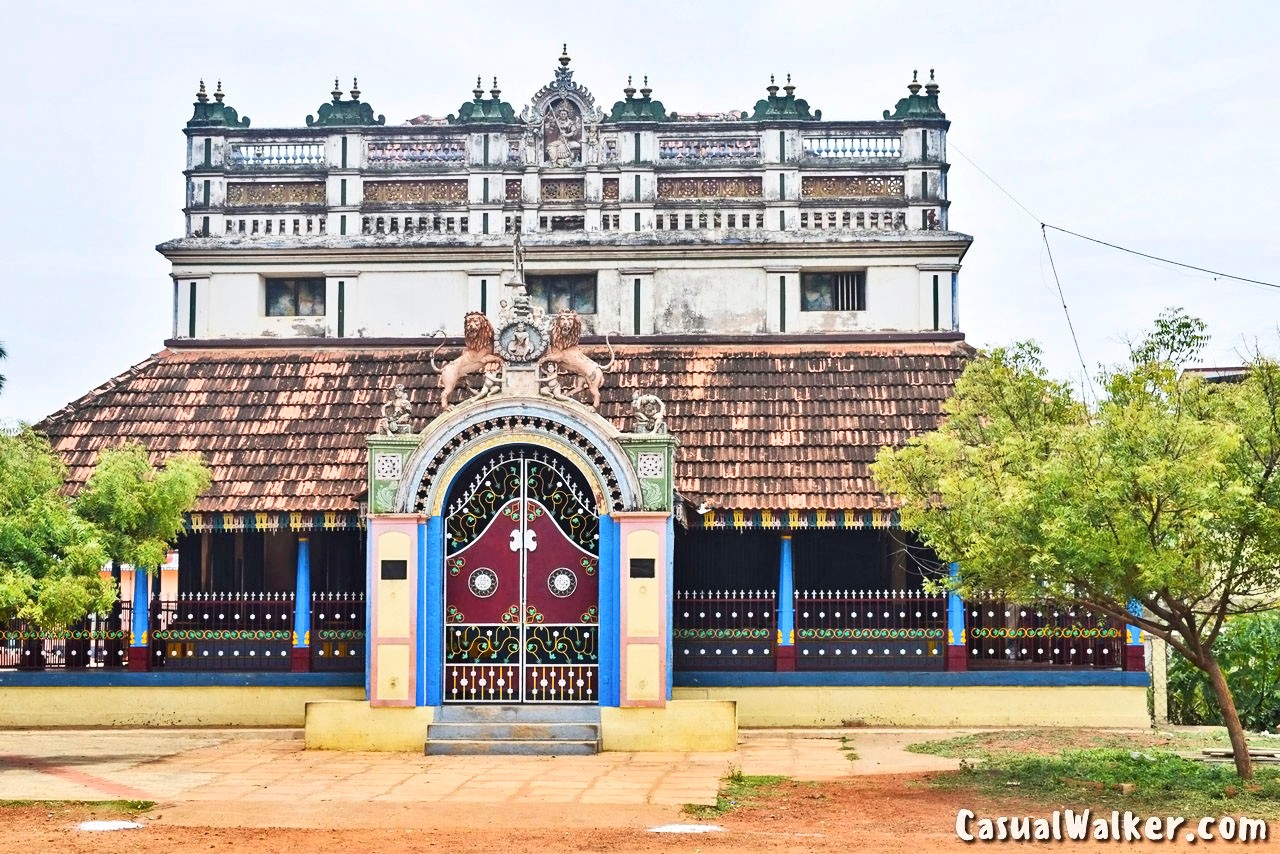
Chettinad Regions – Major Chettiar Settlements
The Chettiar settlements unfold a captivating narrative of cultural heritage and urban evolution. Comprising three distinct series of villages, these Chettiar enclaves weave a tale that spans generations.
First Cluster: Kanadukathan, Pallathur, Kottaiyur, and Kothamangalam (Sivagangai District):
The first cluster has four villages in the Sivagangai District. Among these, Kottaiyur stands out, basking in the traditional glory while being subtly touched by the fingers of urban development. Its proximity to Karaikudi, the bustling economic hub of the region.
Second Cluster: Karaikudi, Kandanur, Athangudi, and Chokalingampudur (Sivagangai District):
Moving southward, the second series of Chettiar settlements includes the prominent urban center of Karaikudi, pulsating with commerce and culture. Intertwined with this urban core are the rural gems of Kandanur, Athangudi, and Chokalingampudur. Each village carries a distinct hue of Chettiar tradition, creating a mosaic of heritage amidst the rural landscapes.
Third Cluster: Rayavaram, Kadiapatti, and Arimalam (Pudukottai District):
Venturing northward into the Pudukottai District, the third and final series of Chettiar settlements includes the villages of Rayavaram, Kadiapatti, and Arimalam command attention with their historical significance. This northern cluster adds another layer to the rich tapestry of Chettiar culture, echoing tales of the past while embracing the transitions of the present.
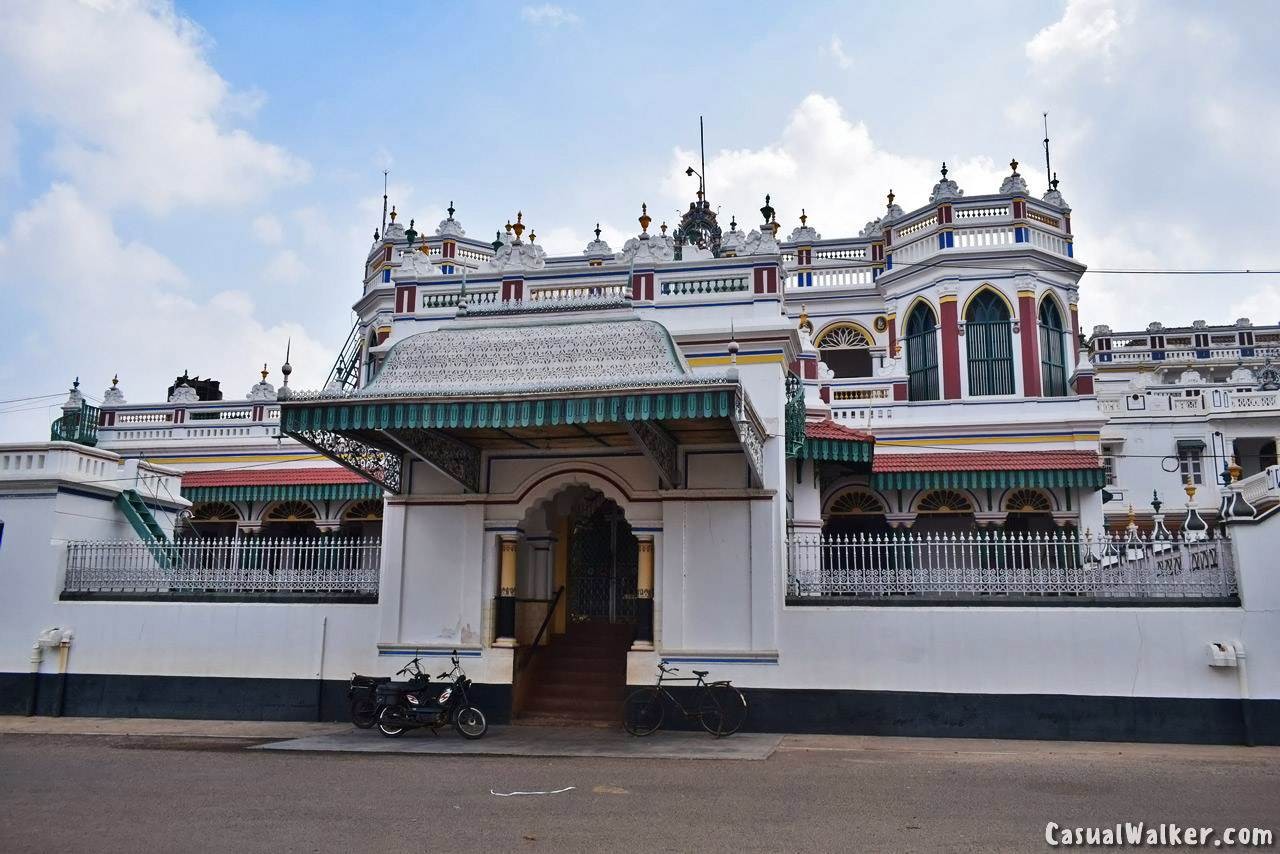
Chettinad Architectural Layout: Blending Traditions and Influences
Chettiar houses echo the cultural richness of the Nagarathars, who, having thrived in Burma, Singapore, and Malaysia, brought back influences from these regions. The interiors of Chettinad houses boast a harmonious blend of Burma teak, Ceylon satinwood, Italian marble, Belgian glass, Dutch ceramic tiles, cast iron, stained glass, and Bohemian chandeliers, enriched by brassware and Tanjore paintings that reflect the unique taste and prosperity of the Nagarathar community. It’s like a symphony of materials, each contributing to the unique melody of Chettinad architecture.
The architectural layout of Chettinad houses seamlessly blends traditional Indian and colonial influences. Built around a central courtyard, these houses feature interconnected rooms arranged around them. Grand staircases provide access to the upper floors, with ground-floor rooms serving as spaces for entertaining guests.
Ornate doorways, intricate wood carvings, and frescoes decorate these rooms, creating a visually rich experience. The upper floors, designed for living quarters, offer privacy and protection from the region’s heat and humidity. Large verandas or balconies overlook surrounding gardens, adorned with intricate tile work, providing cool and shaded areas for relaxation or socializing.
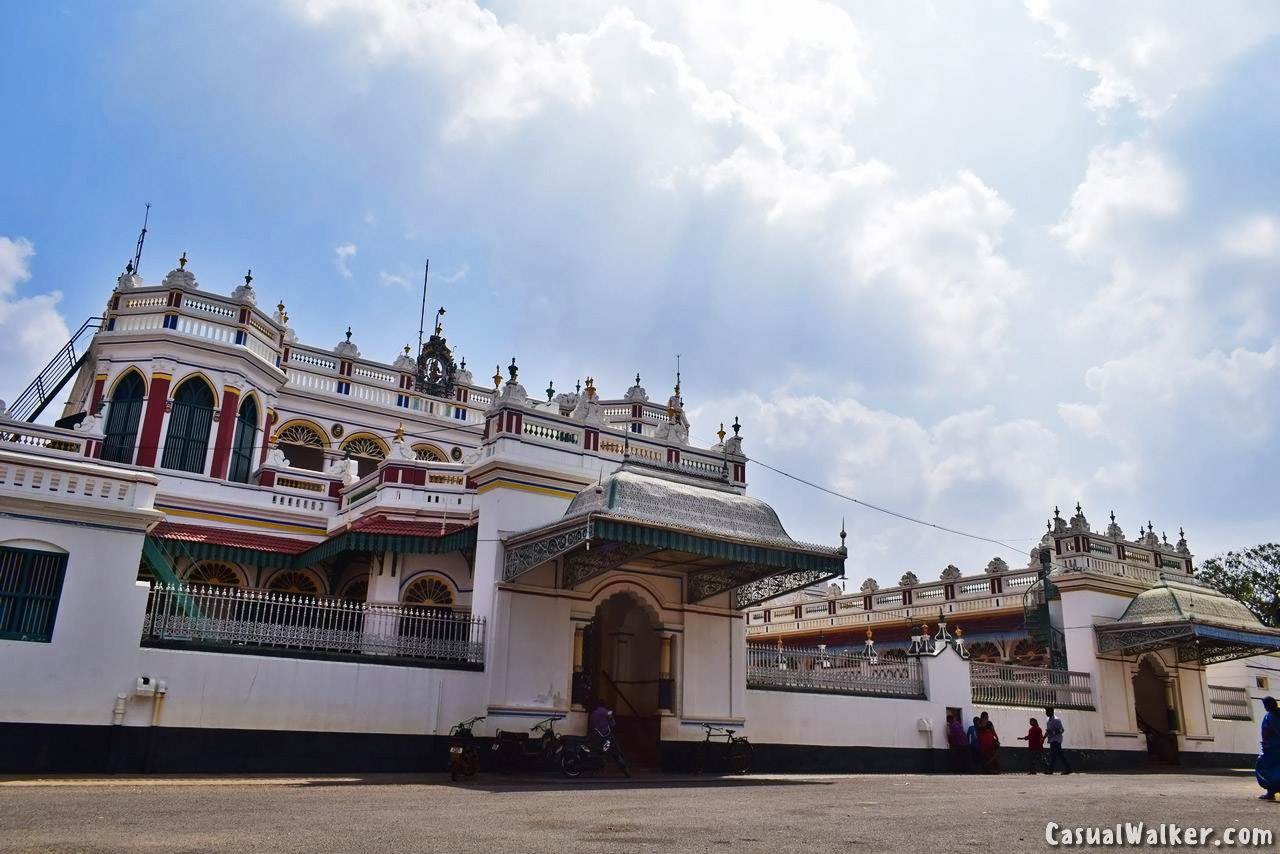
These houses boast wide inner courtyards and spacious rooms, designed with intricate details that reflect the cultural richness of the region. The “thinnai,” an enclosed courtyard, is a central feature, surrounded by family rooms. The walls, coated with a special plaster mixture of powdered shell, lime, jaggery, and spices, maintain a cool interior during the sweltering Indian summers. A testament to harmony with nature, Chettiar homes are characterized by high ceilings and excellent ventilation.
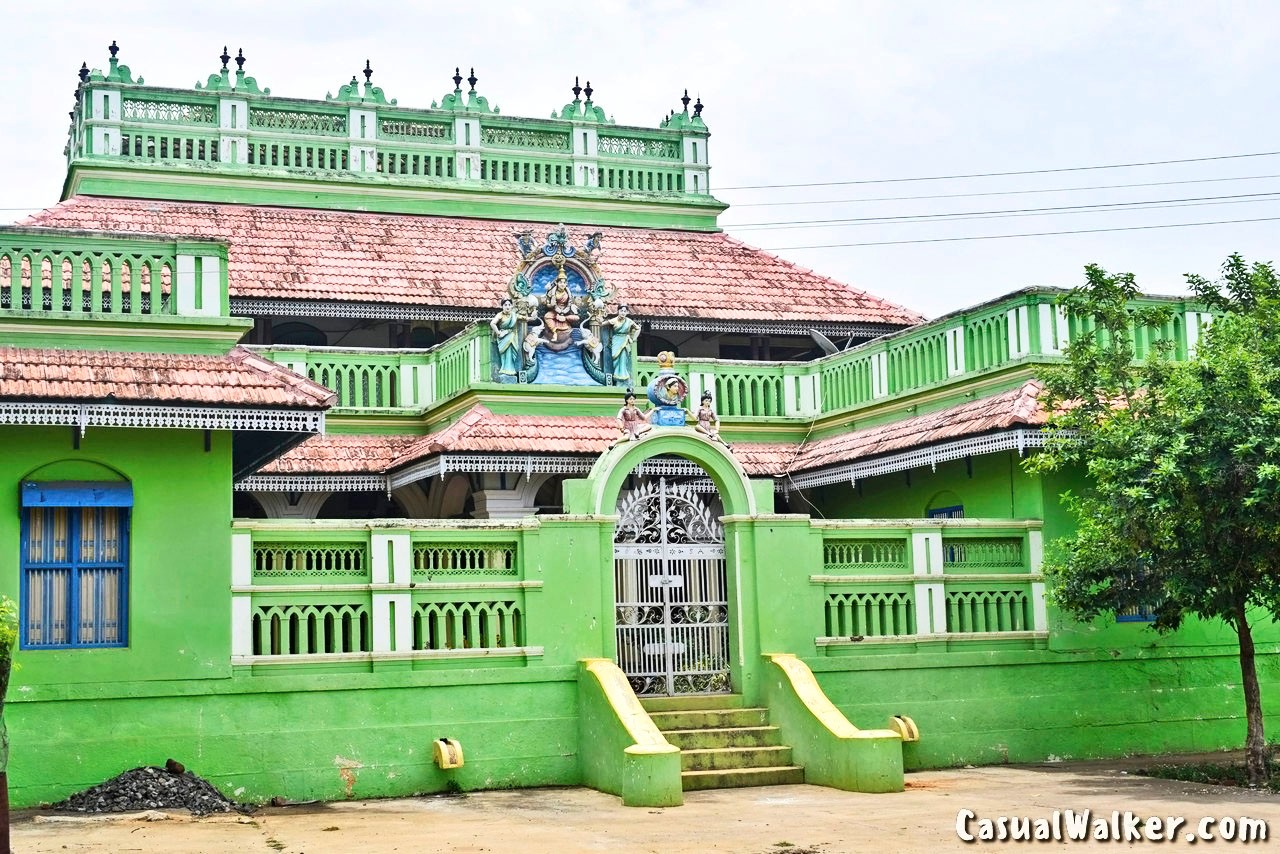
The Grand Entrance: Imposing and Elaborate
Every Chettinad house welcomes you with an imposing entrance adorned with Hindu mythological carvings and opens into an inner courtyard featuring pillars crafted from granite or teakwood. These doors open into a massive hall, the heart of the home, where columns made of elaborately carved wood showcase the craftsmanship of a bygone era.
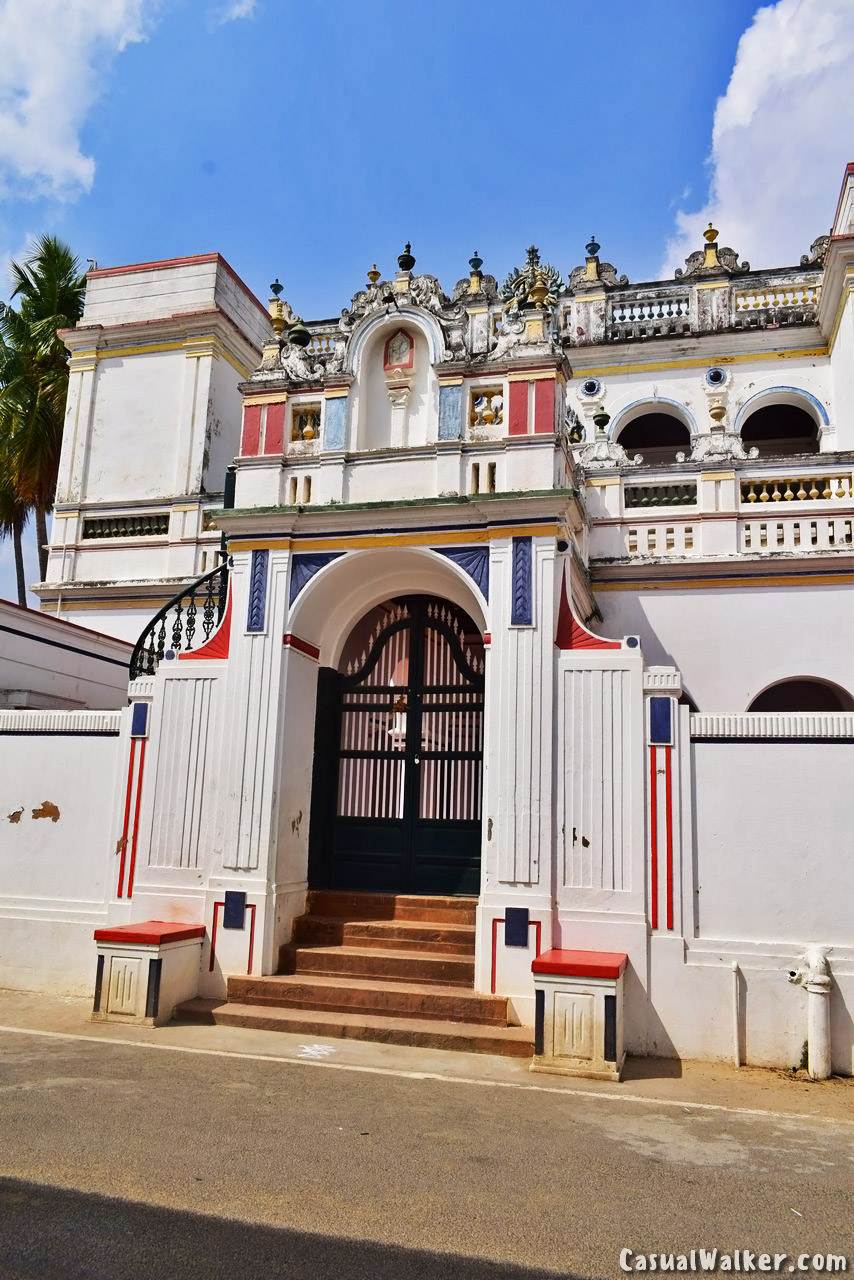
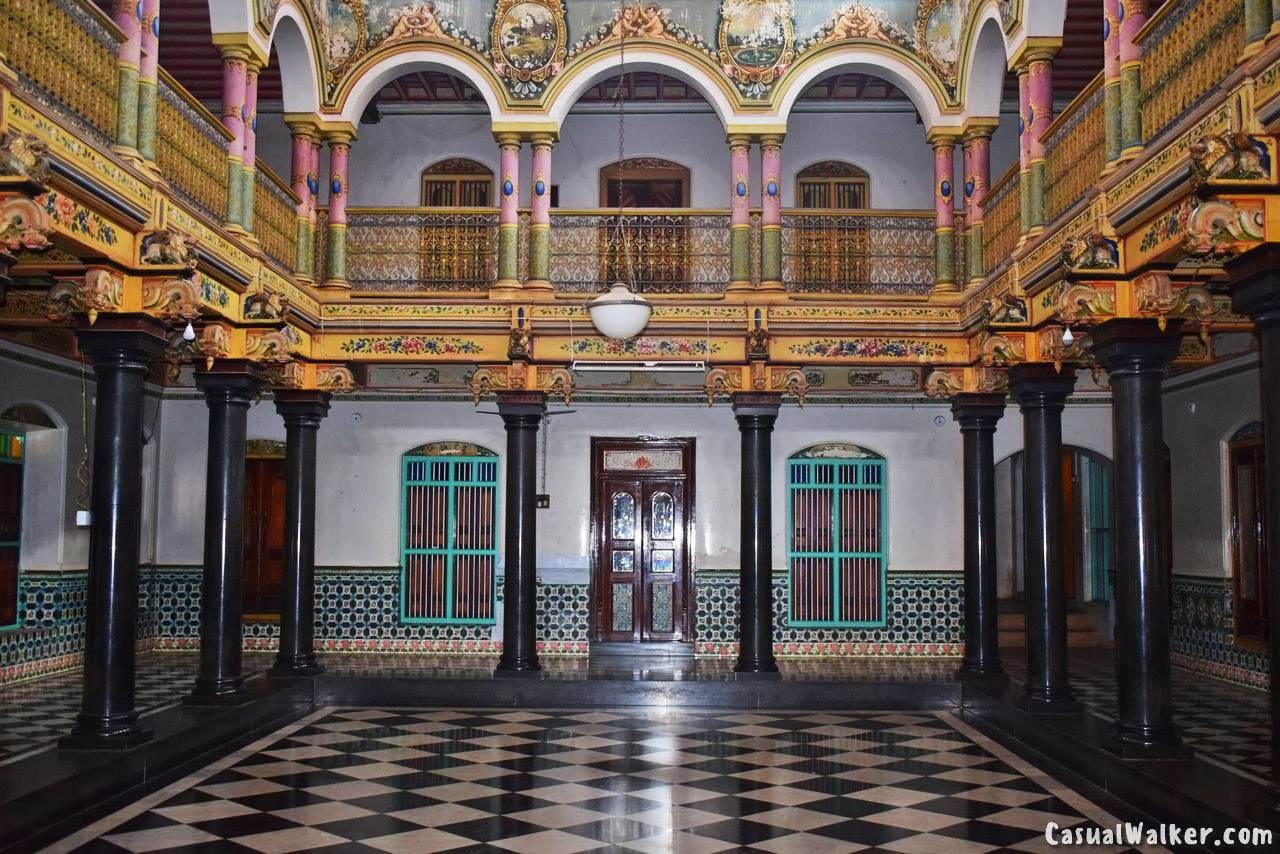
Courtyards: The Soul of Chettinad Homes
Courtyards, an integral part of Chettinad architecture, play a central role in the daily life of these homes. The presence of two large raised platforms called the “Thinnai” on either side of the entrance adds a touch of grandeur. One courtyard, known as “Onnam Kettu,” leads into another rectangular hall, “Randam Kettu,” designated for women.
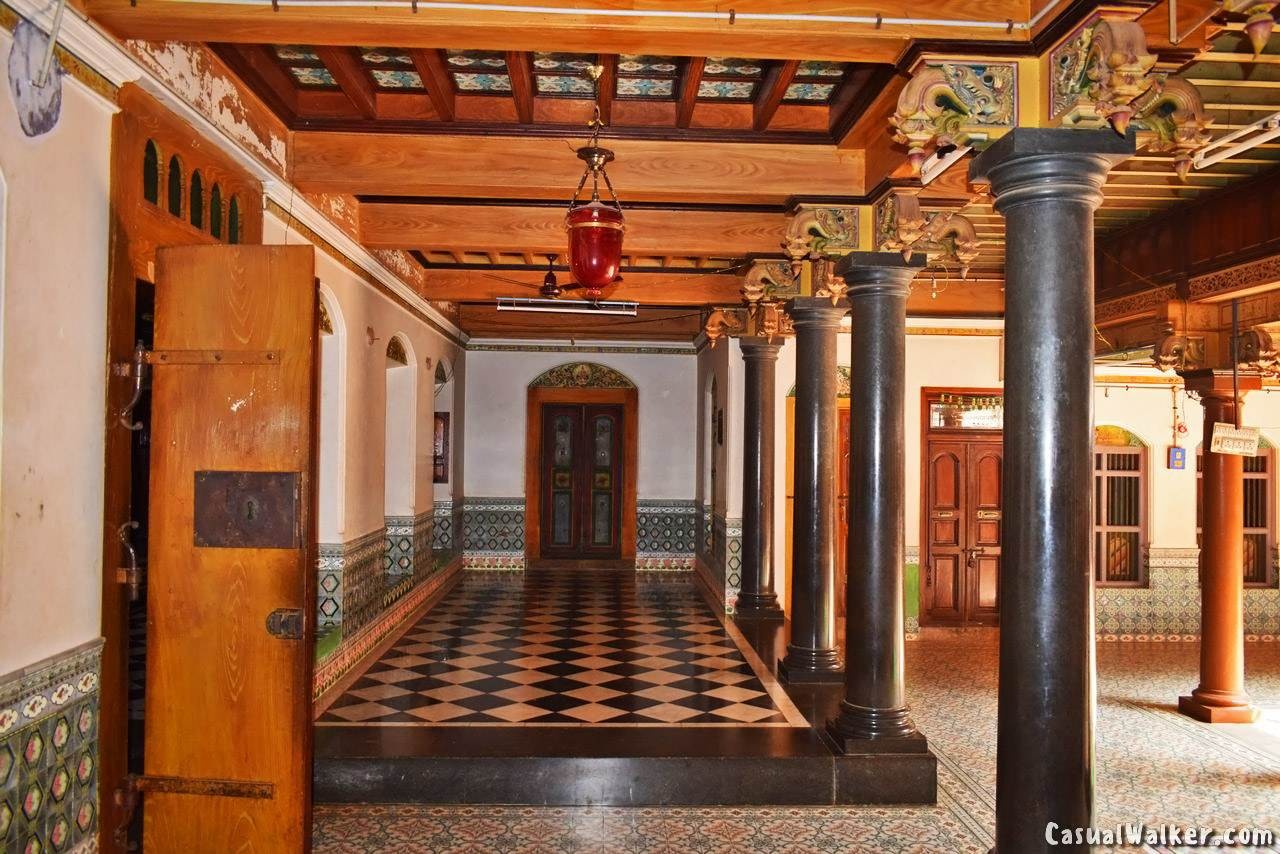
Beyond their functional role, they provide natural ventilation and light, contributing to the overall beauty and charm of the architecture.
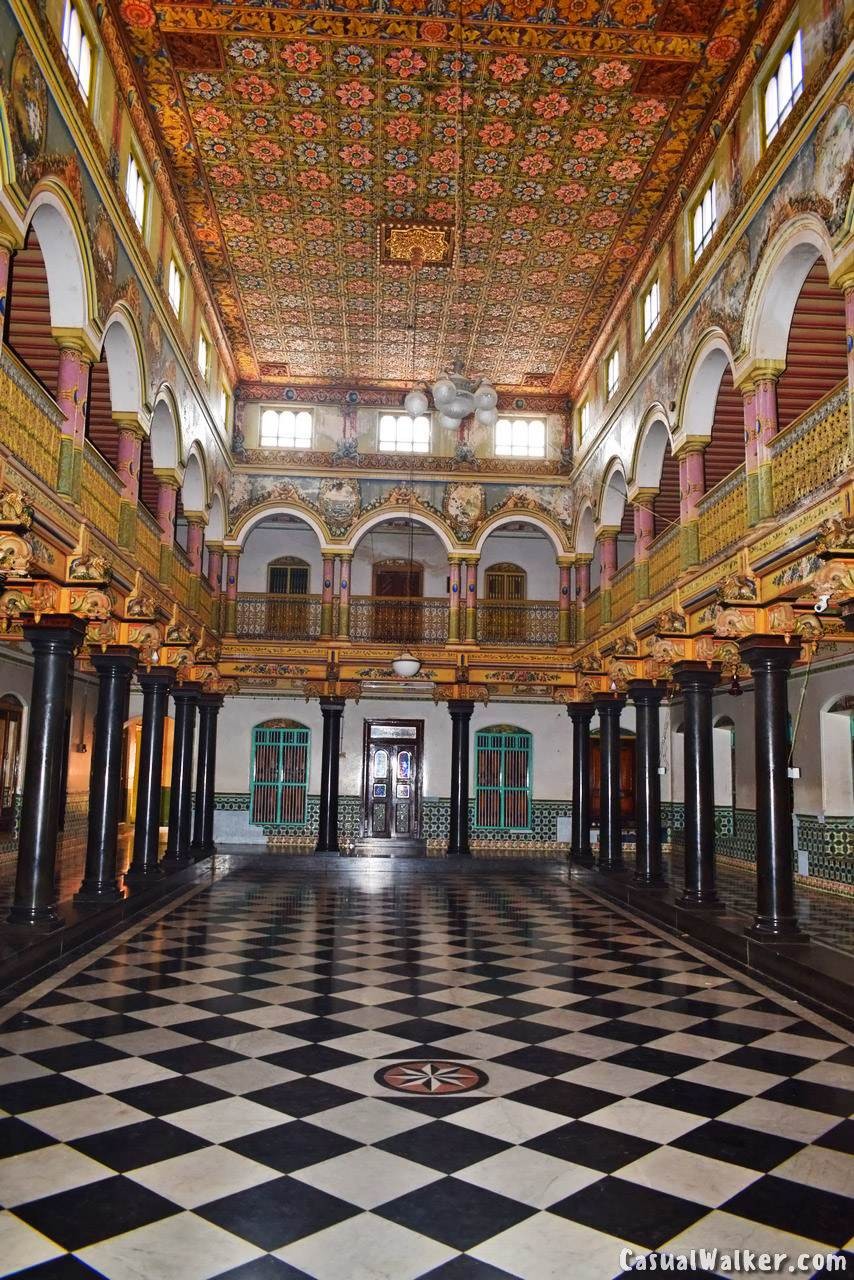
Read More:
Chettinad Kanadukathan Palace and Attangudi / Athangudi Palace, Karaikudi Visit, Travel Guide
Chettinad House Interiors
Beyond being cherished by locals, Chettinad interiors have become a global tourist attraction. The allure of the architecture and the promise of a culinary journey draw visitors from around the world.
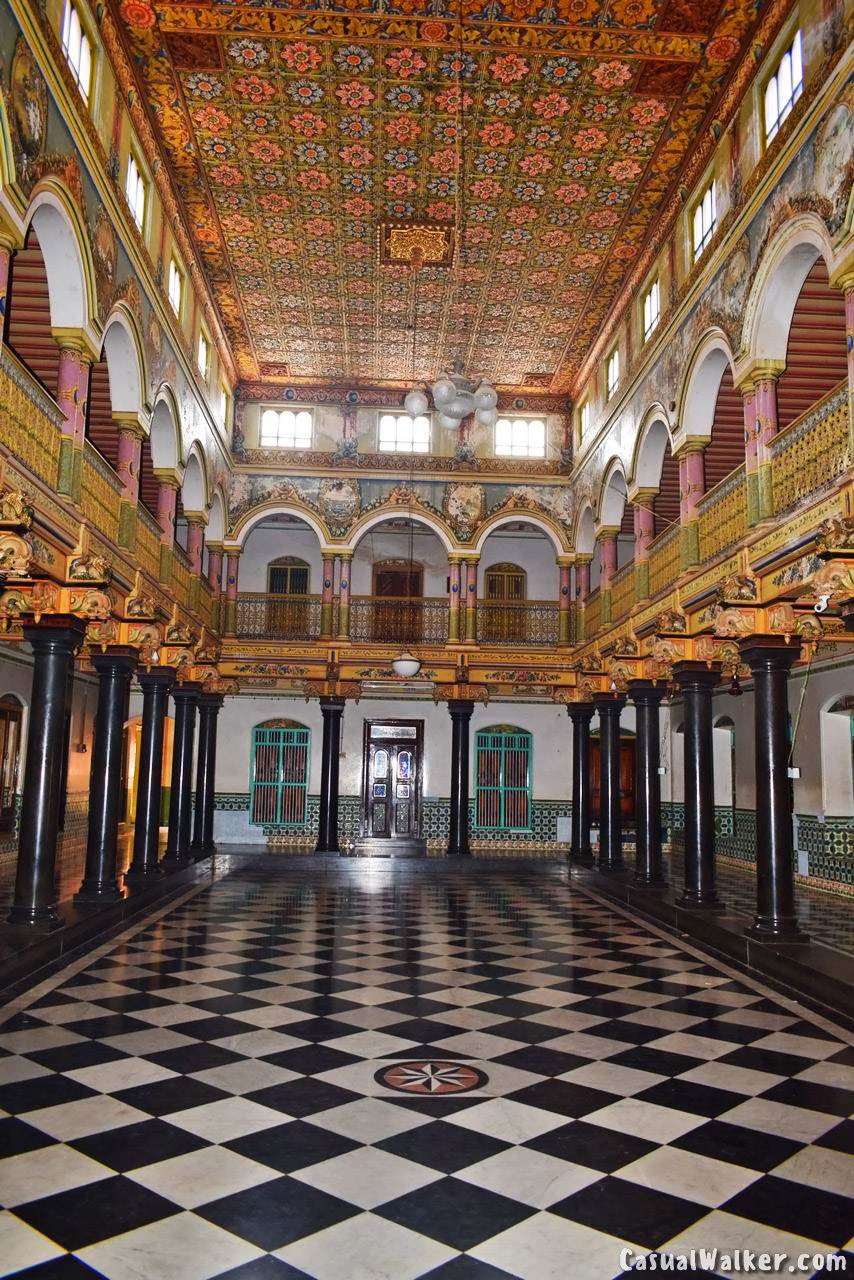
Athangudi Tiles: A Kaleidoscope of Colors
Athangudi tiles are world-famous colorful tiles that are a visual feast, showcasing a variety of hues and patterns. Crafted from locally sourced clay, skillful hands mold and glaze them into intricate designs. Skillfully burned and glazed by hand, Athangudi tiles add a special shine, making them the perfect choice for both indoor and outdoor applications. Ideal for indoor and outdoor applications, Athangudi tiles add a special shine to walls and floors, making them a standout feature in Chettinad homes.
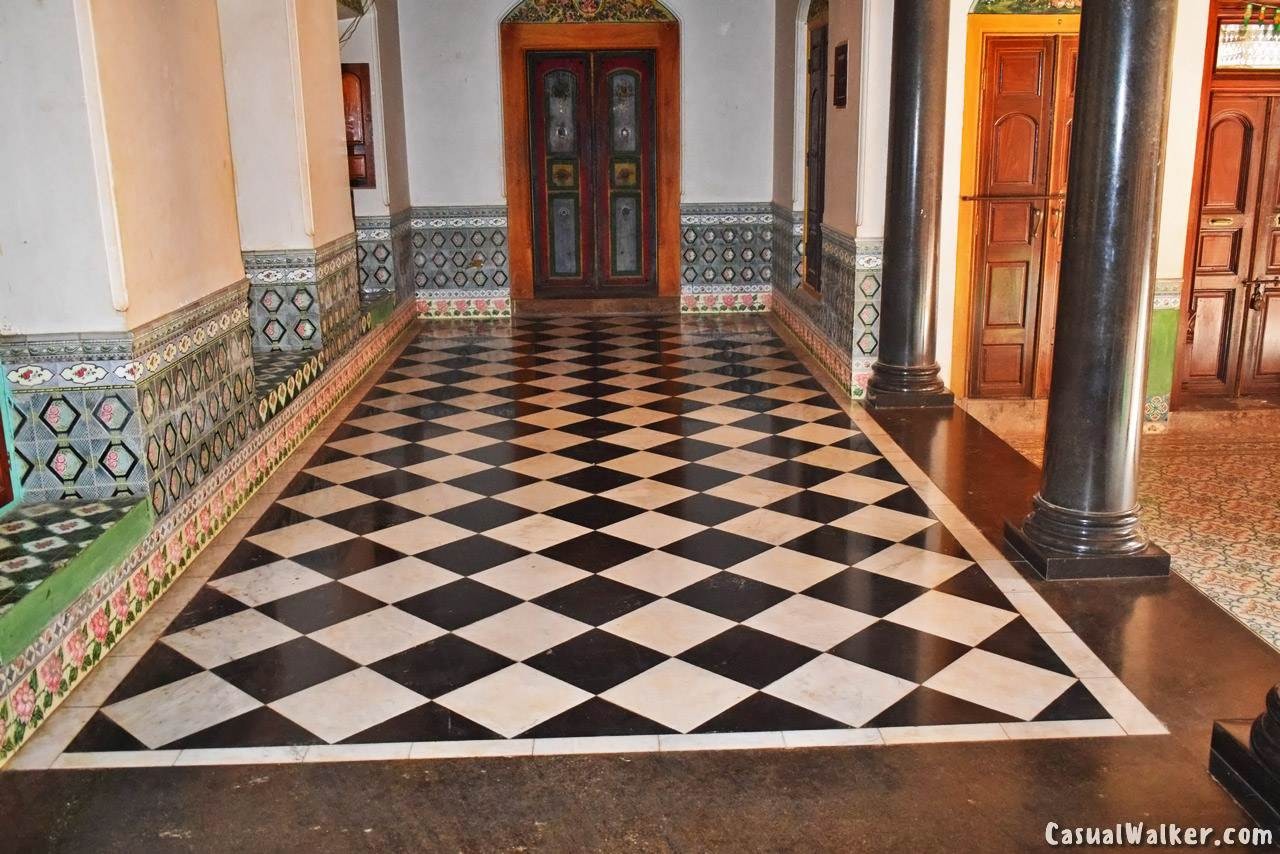
Carved Pillars and Doors: Artistry in Wood and Stone
Chettinad houses are captivated by the beauty of their carved pillars and doors. These artistic elements, often used in the construction of palaces and temples, are works of unparalleled craftsmanship. Crafted from wood, stone, or granite, the intricately detailed pillars showcase meticulous attention to design. Majestic doors, carved with precision, stand as a testament to the architectural prowess of Chettinad houses.
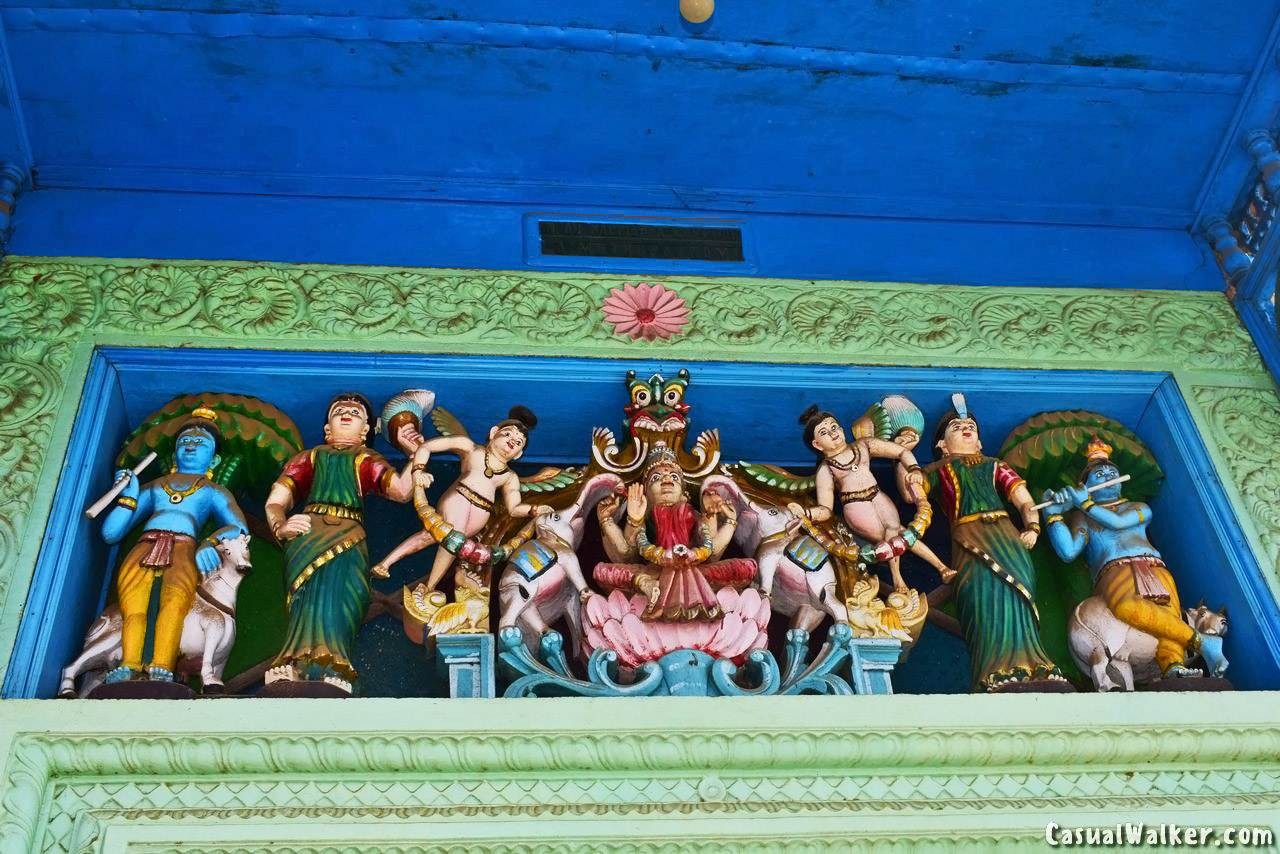
Stucco Work: Preserving Cultural Heritage with Artistry
Stucco work, a decorative plastering technique, finds its place in Chettinad houses, preserving the region’s cultural heritage. A mixture of lime, sand, and water is applied to surfaces, and sculpted into intricate designs inspired by traditional Indian motifs. Layers of stucco, highlighted with paint or gold leaf, result in a dramatic effect, adding a unique and beautiful touch to Chettinad architecture. This intricate process requires skill and expertise, showcasing the craftsmanship and artistry of local talent.
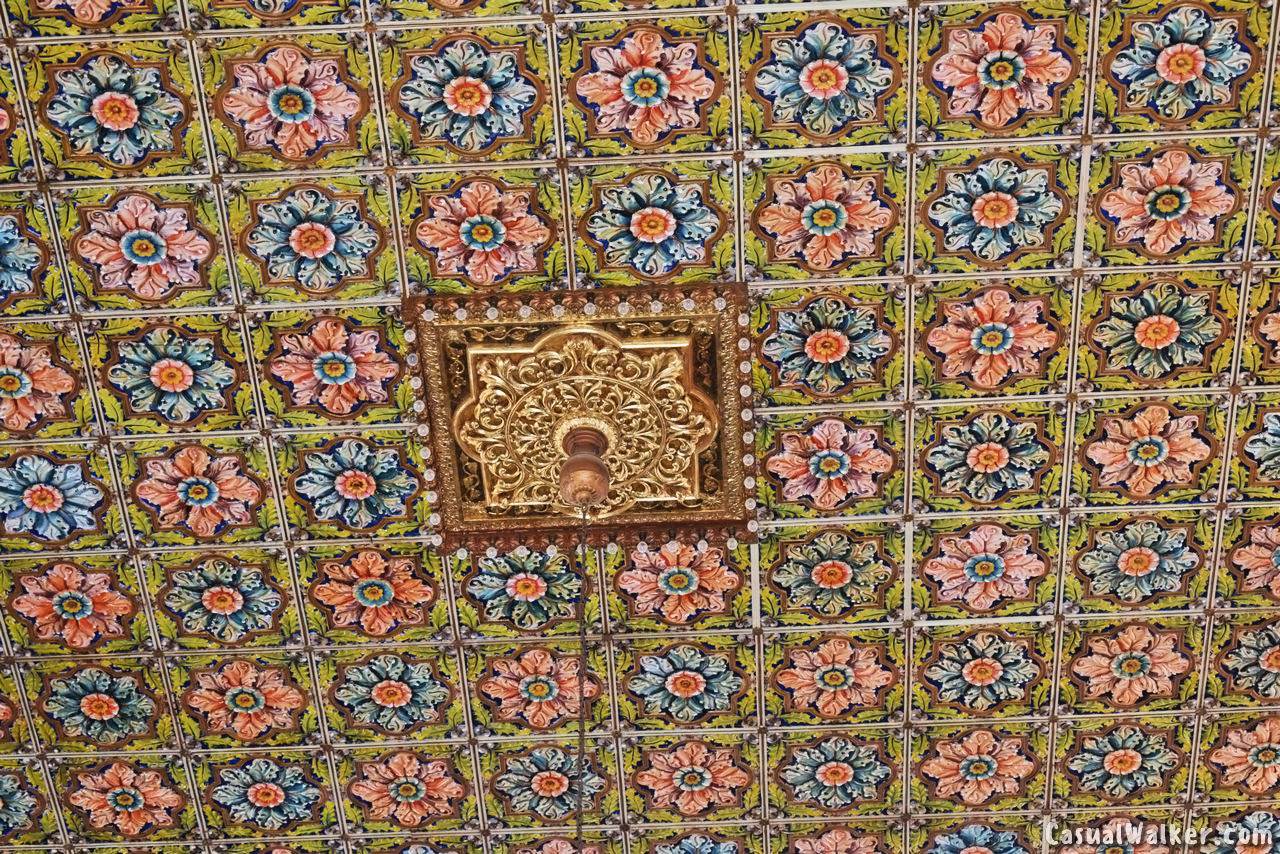
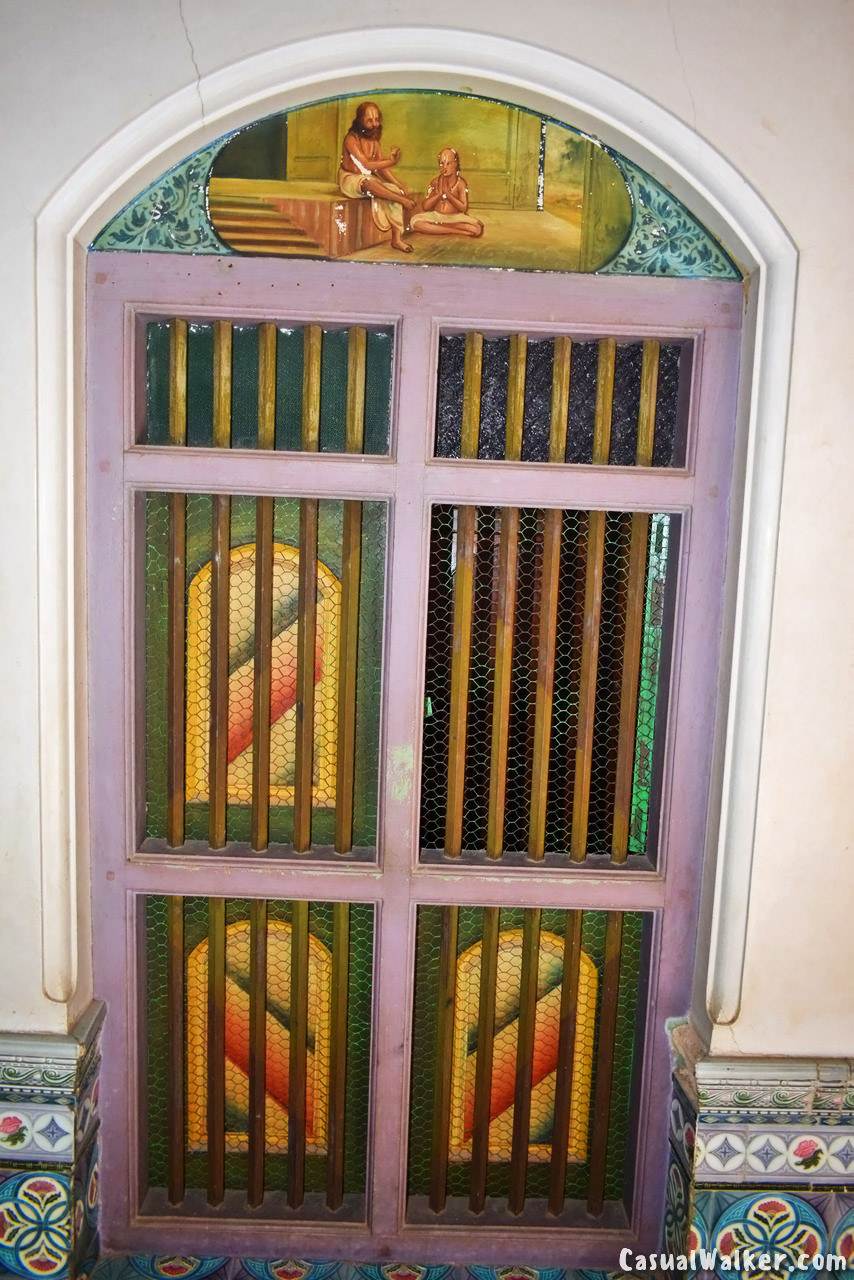
Culinary Food Delights
Chettinad’s gastronomic offerings are a feast for the senses, holding a special place in the hearts of food enthusiasts. The Chettinad style, known for its distinct flavors and aromatic spices, caters to both vegetarians and non-vegetarians. Beyond the familiar South Indian dishes, the Nagarathars have curated a list of unique snacks like Karupatti Paniyaram, Pal Paniyaram, Thenkuzhal, Seepu Seedai, and more that tantalize taste buds. Each dish is a celebration of tradition, color, and culinary expertise, making Chettinad a haven for food connoisseurs.
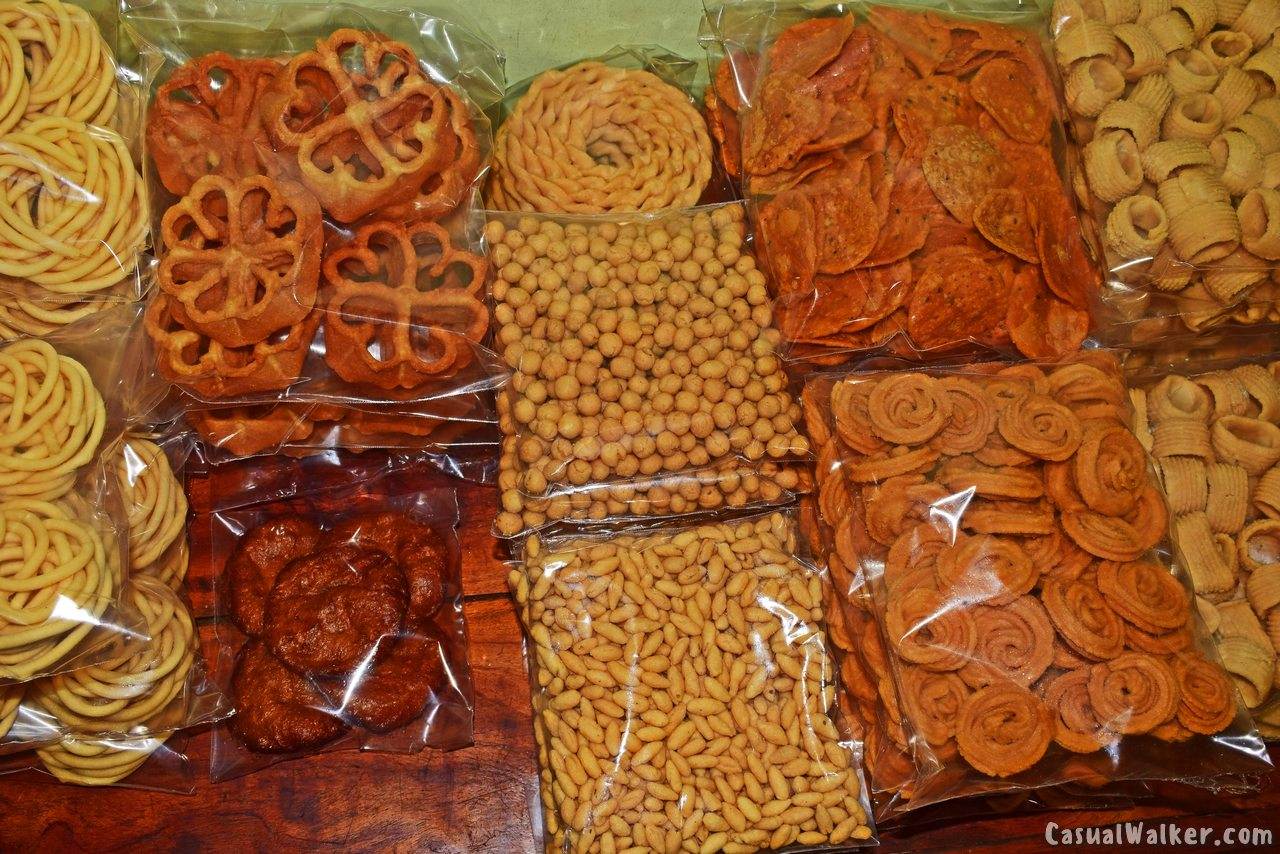
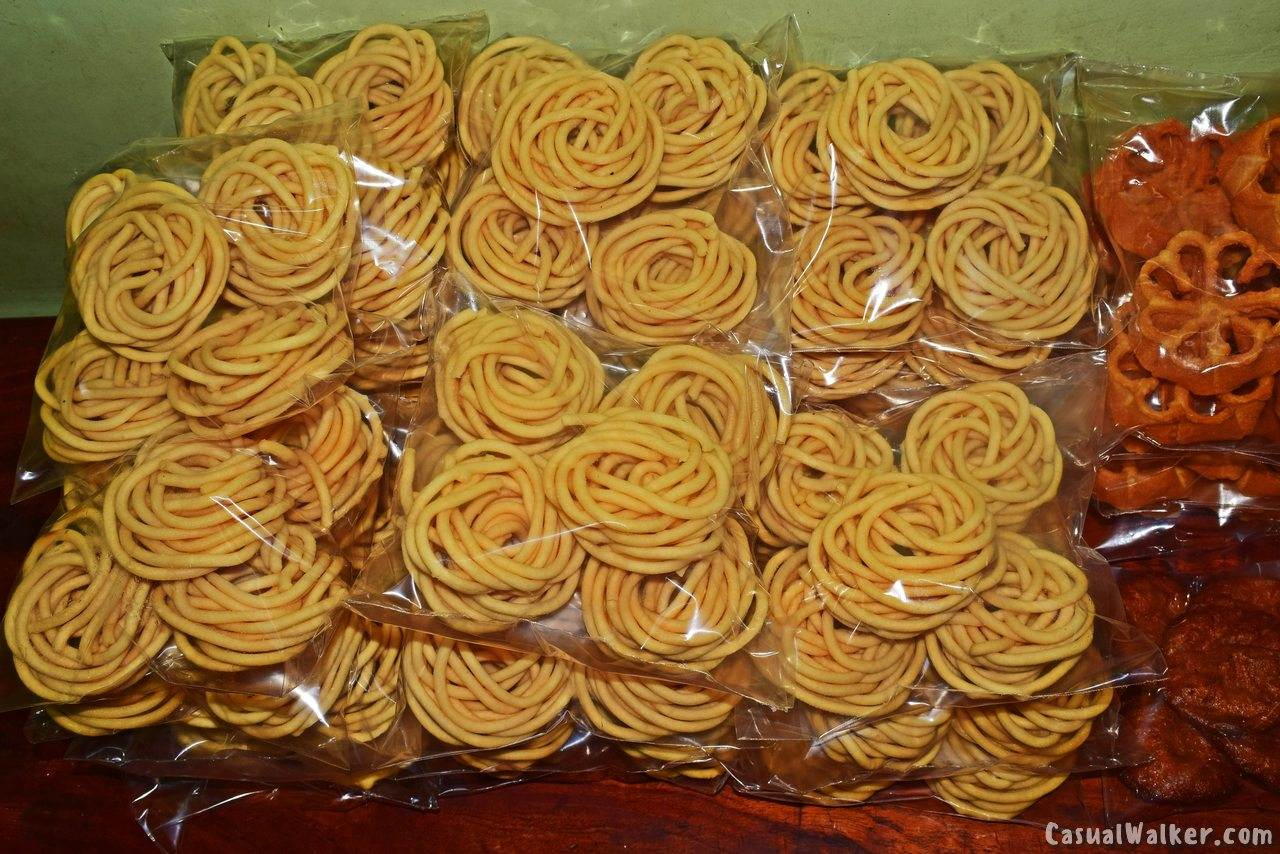
Read More:
Pitched Roofs: A Functional and Aesthetic Touch
Pitched roofs, a common feature of Chettinad houses, add a unique architectural style and attention to detail. Typically made of clay tiles or thatch, these roofs protect homes from heavy monsoon rains. Supported by intricately carved and decorated wooden beams or columns, the steep slopes of pitched roofs allow rainwater to drain quickly, ensuring the house’s interior remains dry. Beyond functionality, these roofs contribute to the overall beauty, historical significance, and traditional building techniques of Chettinad houses.
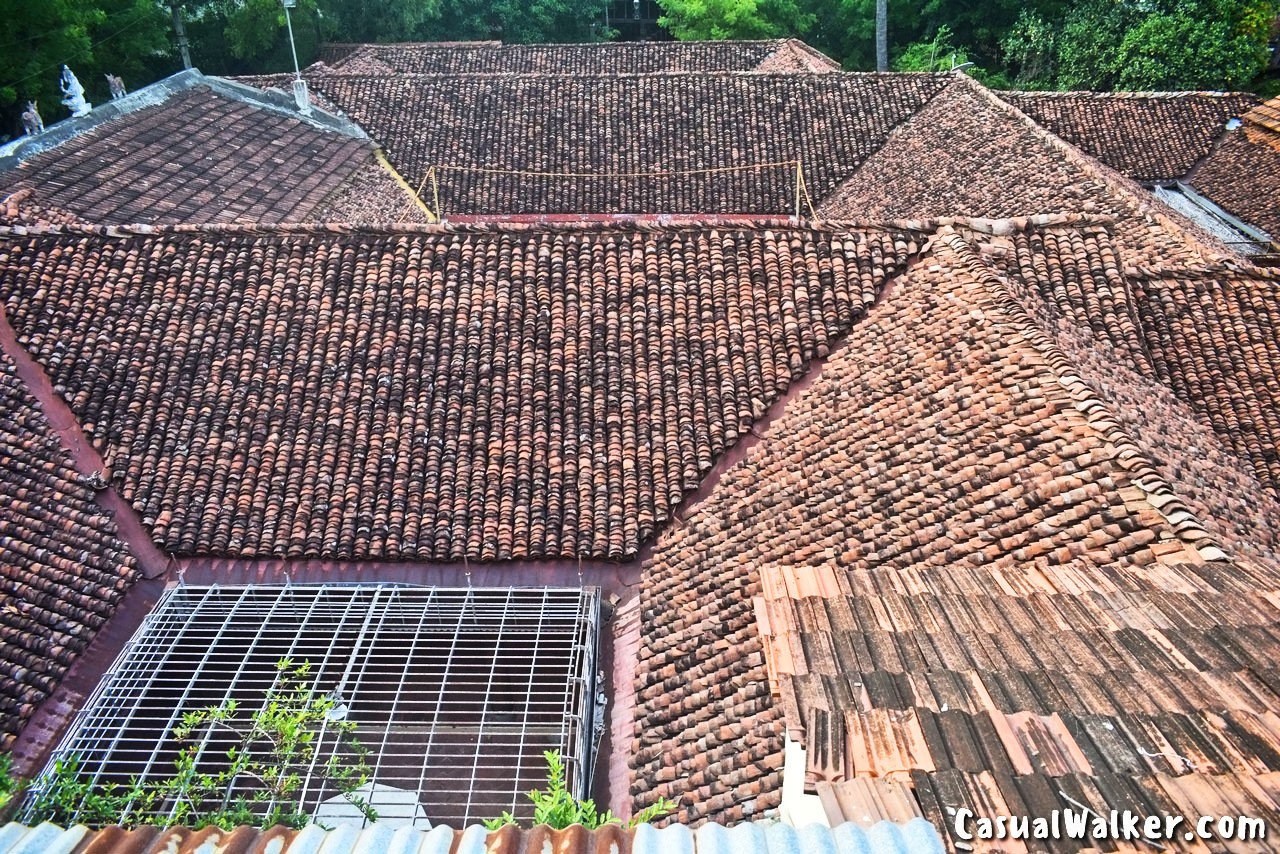
Visiting Famous Chettinad Houses
Banagala – Meyyappan family
Owned by the Meyyappan family, the MSMM House is a visual delight. Guests at The Banagala are in for a treat as they get an exclusive peek into the intricate beauty of this Chettinad mansion.
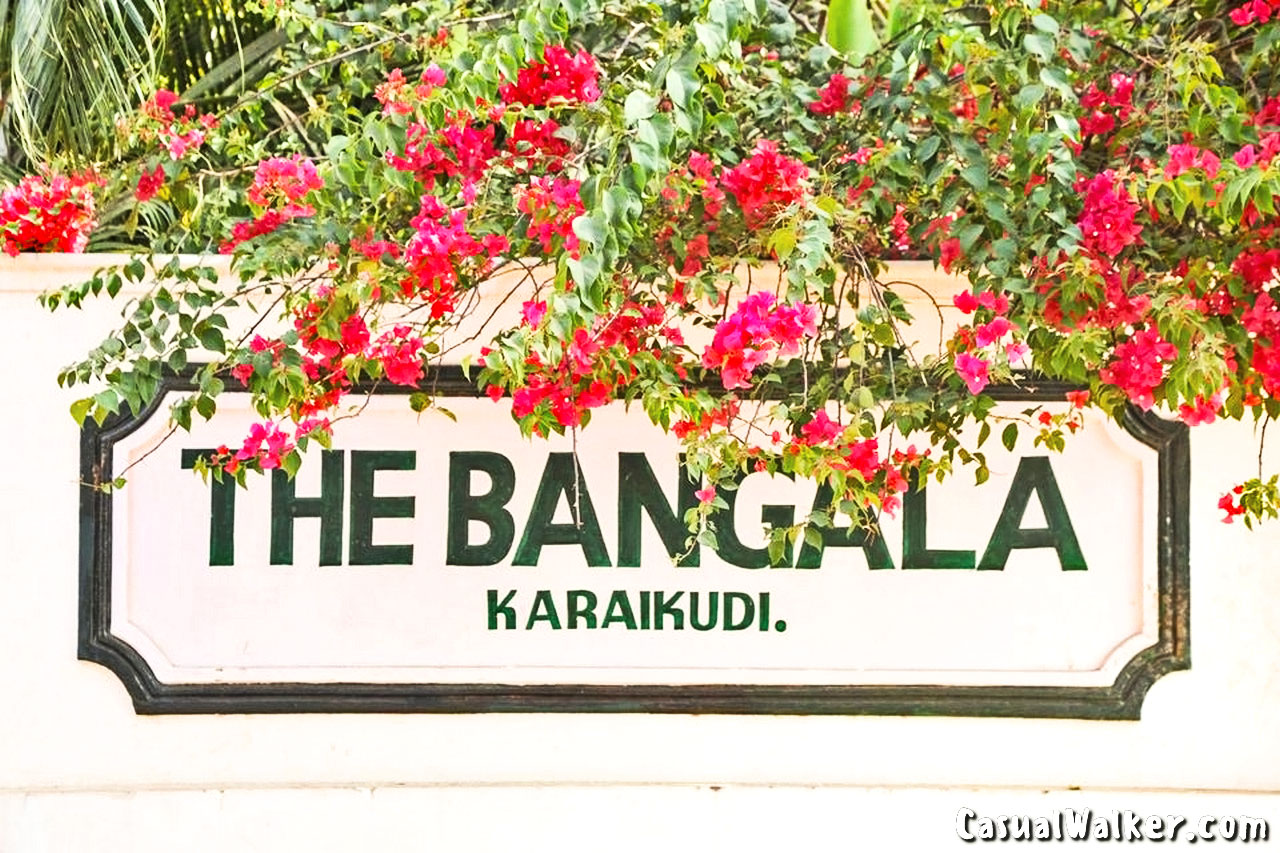
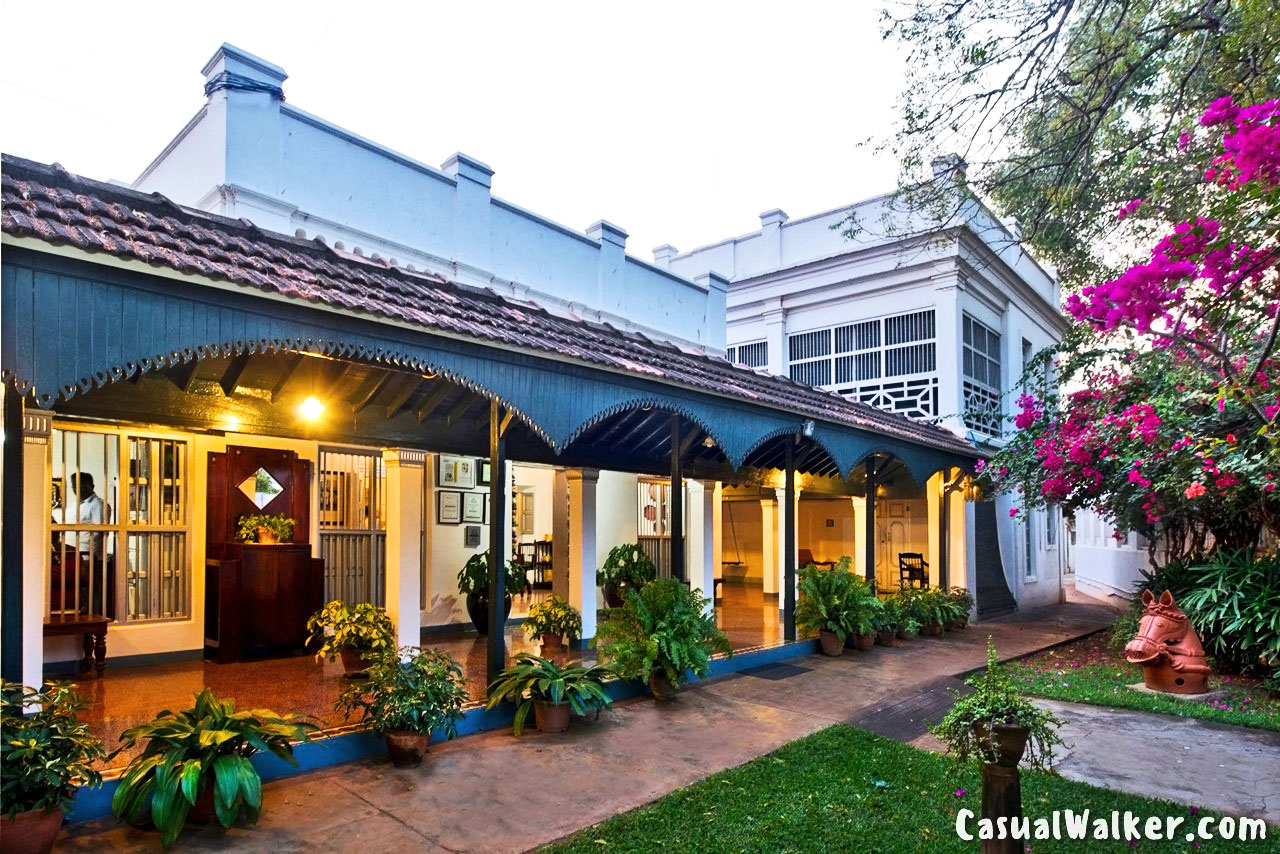
Read More:
Aayiram Janal Veedu – House with a Thousand Windows / Kanadukathan Chettinad House / VVR House
A name that sparks curiosity, the Aayiram Janal Veedu, or the House with a Thousand Windows, stands as a testament to Chettinad’s architectural prowess. The caretakers, often the unsung heroes of these heritage homes, graciously welcome us into their world for a nominal tip of 100 to 200 INR per head.
Chettinadu Mansion
Once a residential masterpiece, Chettinadu Mansion has been transformed into a heritage hotel. Step inside to experience the grandeur of Chettinad’s past while enjoying the comfort of modern hospitality.
Lakshmi Vilas
A beautifully renovated mansion that has evolved into a stunning hotel. Lakshmi Vilas beckons you to immerse yourself in the charm of Chettinad’s heritage.
Chettinadu Palace
While not open to visitors, the mere sight of Chettinadu Palace from the outside is a feast for the eyes. Its architectural splendor reflects the rich history embedded in Chettinad’s soil.
Chettinad Region’s Temples
In Chettinad, the Chettiars community is divided into nine Clan Temples. These temples aren’t just places of worship; they are the spiritual anchors of the Chettiar community. Regardless of where a Chettiar is born, their allegiance lies with one of these temples. The nine Clan Temples scattered across the region are Ilayathangudi, Mathur, Vairavanpatti, Iraniyur, Pillayarpatti, Nemam, Iluppakudi, Soorakudi and Velangudi.

Read More:
Unveiling Chettinad’s Hidden Treasures
Chettinad isn’t just about grand homes and spiritual landmarks; it’s a treasure trove of unique attractions that add layers to its rich tapestry.
Thirumayam Fort: A Glimpse into History
Built in 1687, Thirumayam Fort was built by Sethupathi Vijaya Raghunatha Thevar, the ruler of the Ramnad kingdom, the fort served as a bastion against external invasions and played a crucial role in shaping the region’s destiny. Adjacent to the fort lies the Sathyamurthy Perumal Temple, adorned with a majestic Gopuram. The temple’s intricate sculptures and vibrant colors add to the charm of Thirumayam, offering a spiritual haven amidst the historical grandeur.
Ayyanar Horse Temple: Terracotta Wonders
In the village of Kanadukathan, discover the Ayyanar Horse Temple—an ode to terracotta wonders. The temple is renowned for its life-sized terracotta horses, each a masterpiece of craftsmanship. As you explore this unique sanctuary, marvel at the artistry that brings these horses to life, capturing the essence of Chettinad’s artistic brilliance.
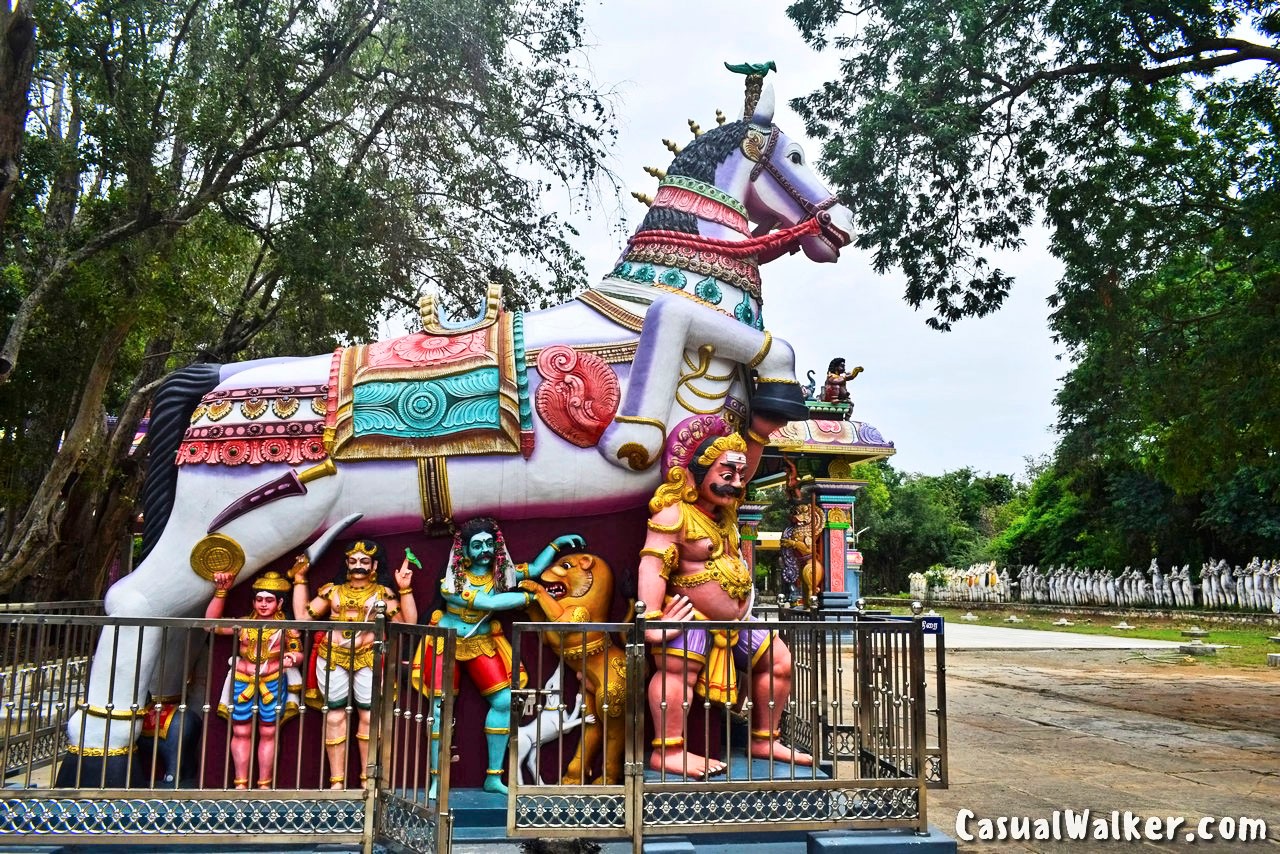
Read More:
Vallal Dr. Alagappar Museum & Tamil Cultural Museum at Alagappa Puram, Karaikudi, Sivaganga: Museum to Sir Alagappa Chettiar
Vallal Dr. Alagappar Museum is a Museum dedicated to Sir Alagappa Chettiar, an educationalist, philanthropist, and Businessman. This Museum is opened at the Alagappa University campus in Karaikudi, Sivaganga district to mark the celebration of the 108th birth anniversary of Sir Alagappa Chettiar.
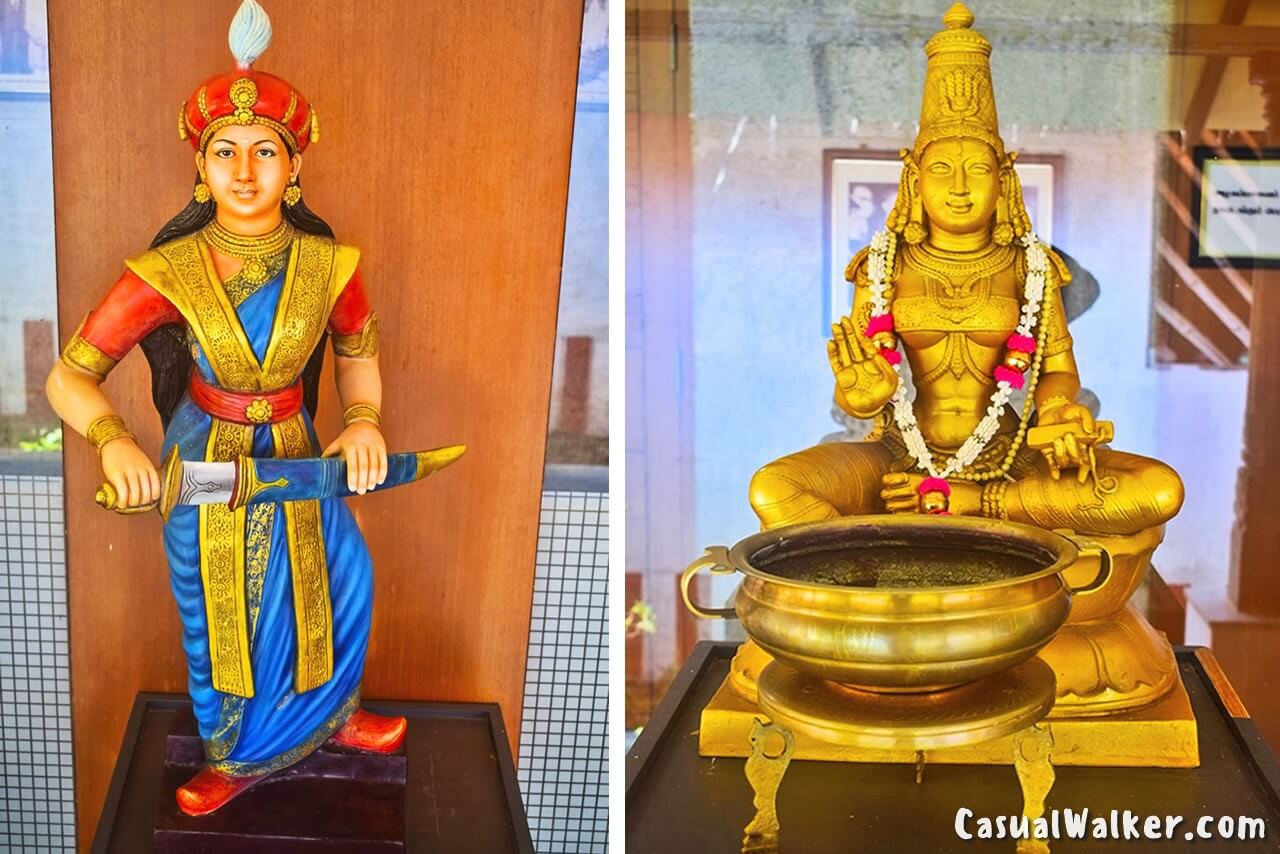
Read More:
Chettinad Kottan- The Chettinad Palmyra Basket
Chettinad kottan – palm leaf products / Palmyra products such as
bags, baskets, and trays called “Kottan” in Tamil, created using dried palm leaf which is available in plenty in the villages in South India. It is one of the famous daily house hold object in Chettinad culture.
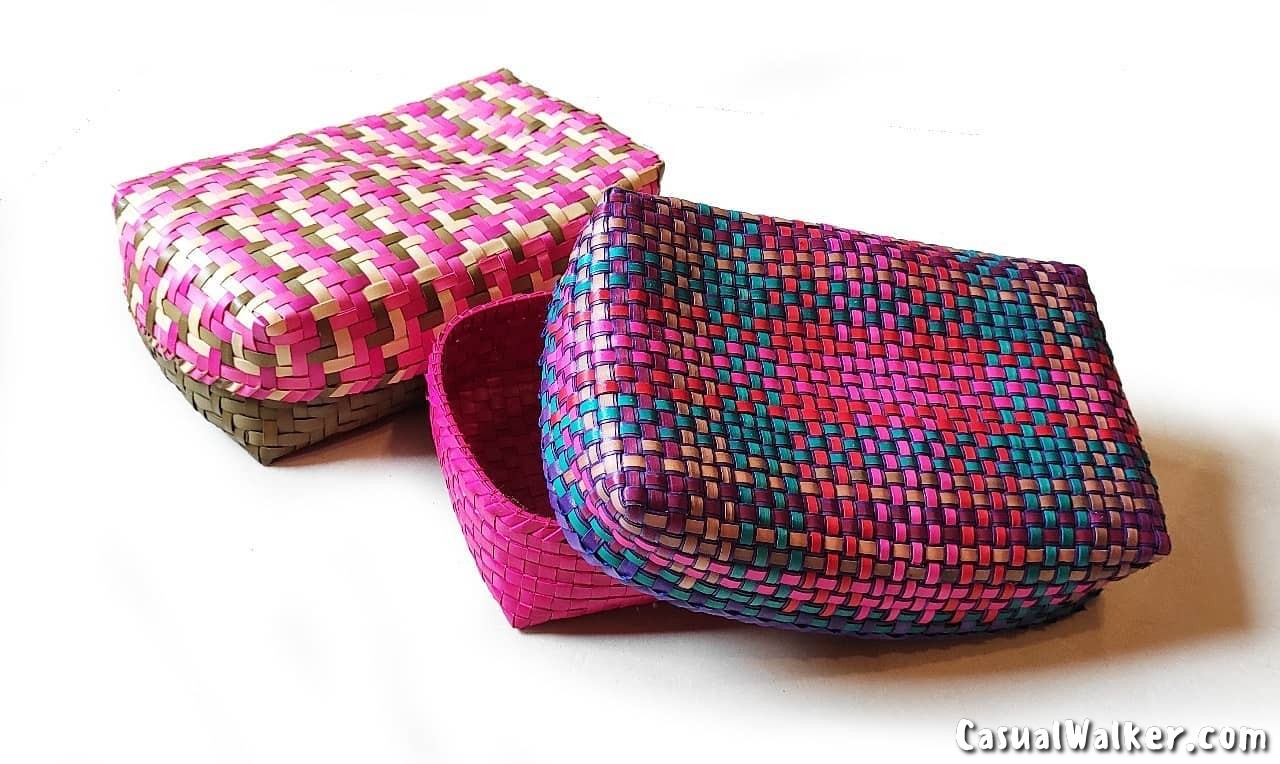
Manjal Store is a Chettinad craft and tradition unit supported by the International award-winning – M.Rm.Rm. Cultural Foundation in Chennai. Manjal is a vibrant and cheerful shop with a wide selection of hand-made, eco-friendly, colorful patterns of palm leaf products / Palmyra Basket.
Read More:
Chettinad, with its opulent houses a symphony of architectural brilliance, blending tradition, opulence, cultural richness, rich cultural heritage, and tantalizing cuisine, stands as a testament to the Nagarathar community’s legacy. As we traverse the narrow thinnai, savor the flavors of Chettinad cuisine, and marvel at the architectural wonders, you’ll find yourself immersed in a world where tradition and modernity coexist seamlessly.
Transport for Karaikudi:
On Road: Karaikudi, Plenty of buses are available from Karaikudi,Thirupathur,Madurai,Tirchy.
Nearest Airport: 87km towards Tiruchirappalli International Airport (Code: TRZ) and 81km towards Madurai International Airport ( Code IXM).
Nearest Railway Station: Karaikkudi Junction railway station (station code KKDI).
Check our Best Places and Tourist Attractions in Chettinad or Chettinadu, Sivaganga District – The Land of Nattukotai Chettiars / Nagarathars
Chettinad Kanadukathan Palace and Attangudi / Athangudi Palace, Karaikudi Visit, Travel Guide
Thiruppakkottai Village & Temple Festival Trip at Sivaganga District Visit, Travel Guide

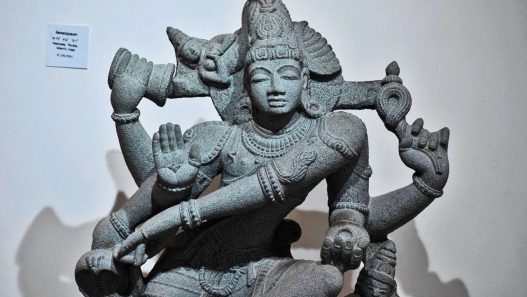

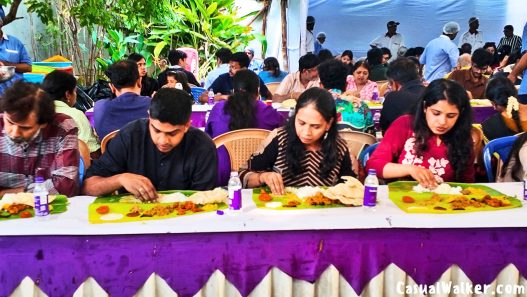

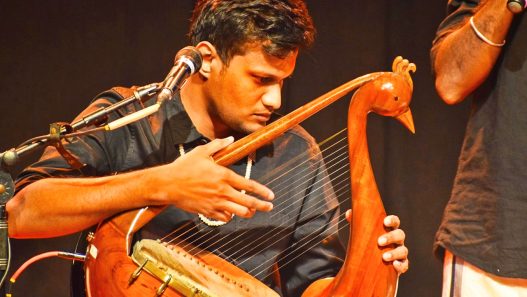



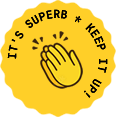
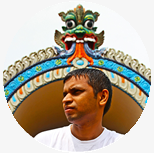

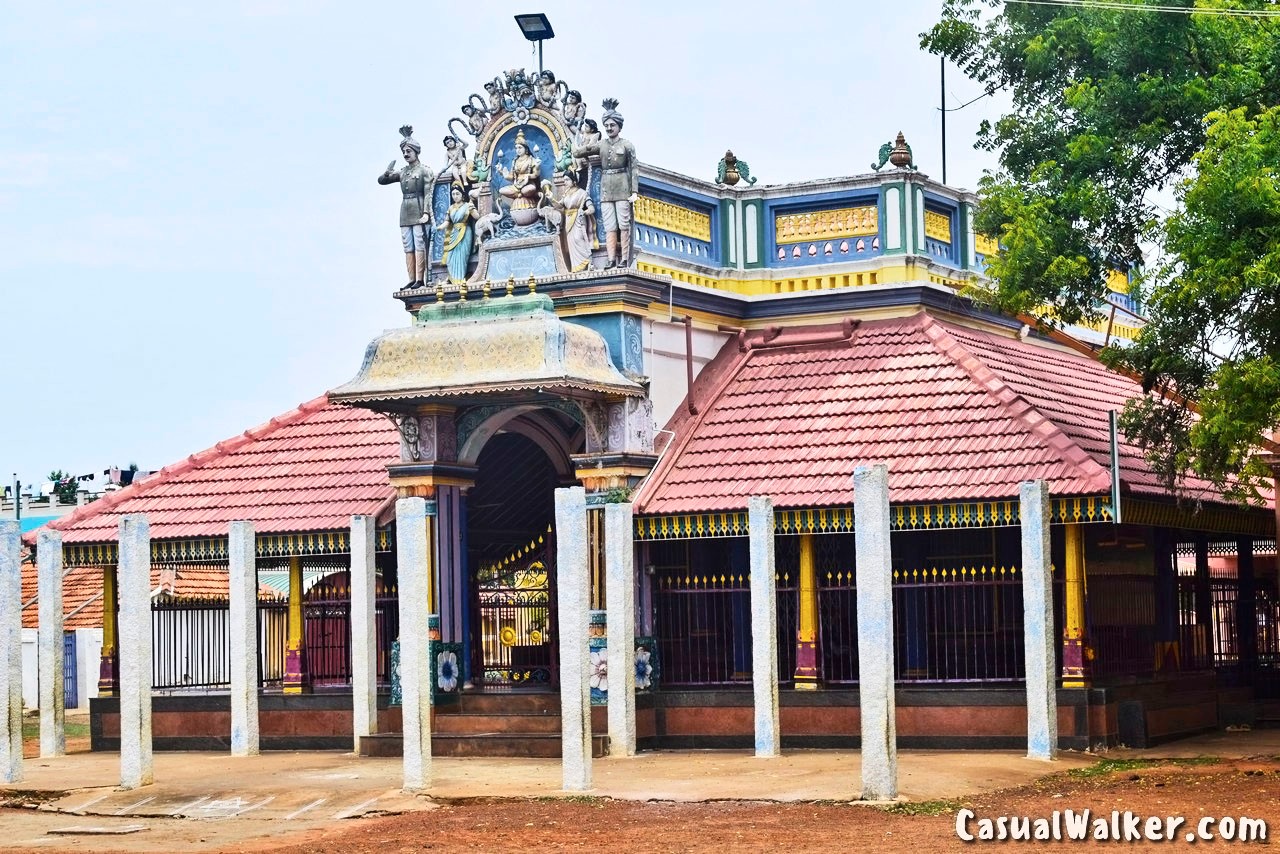
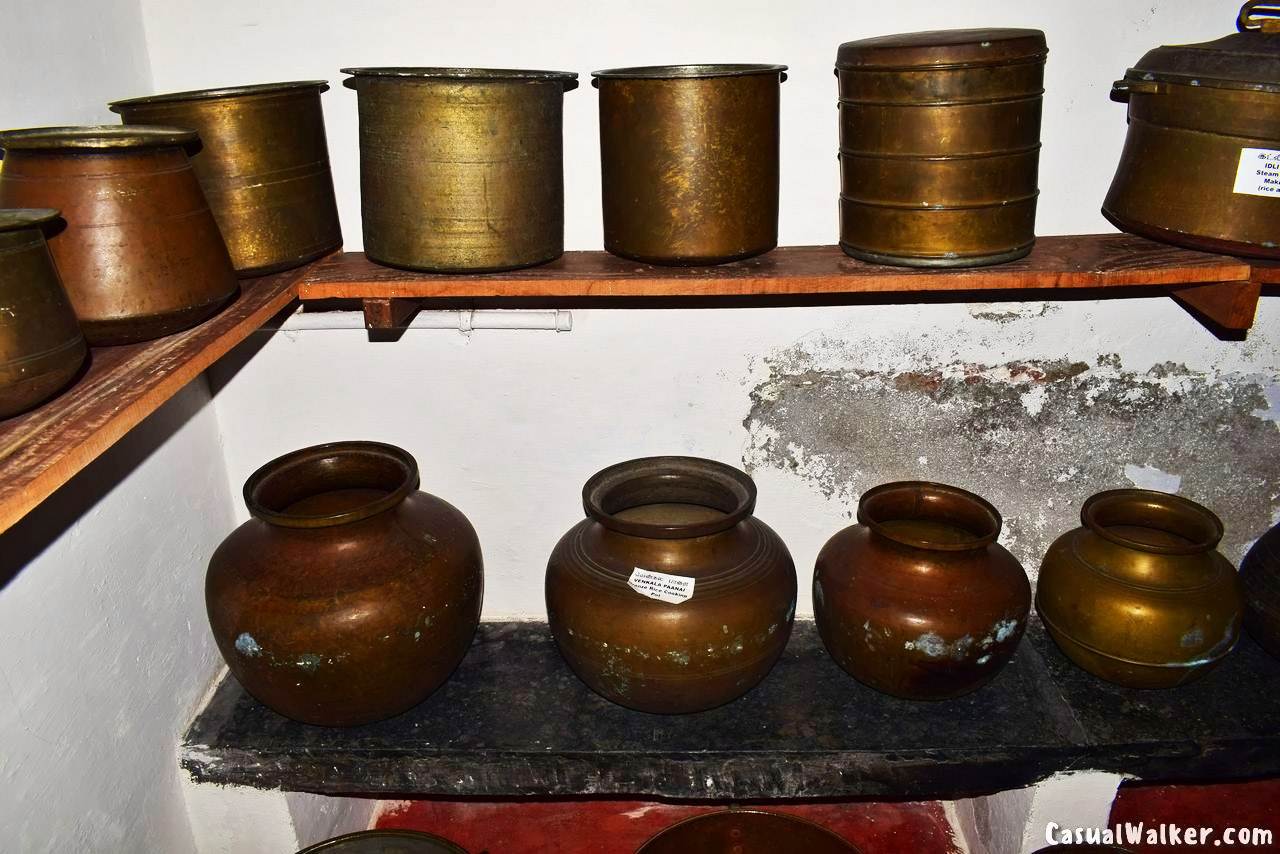












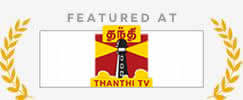



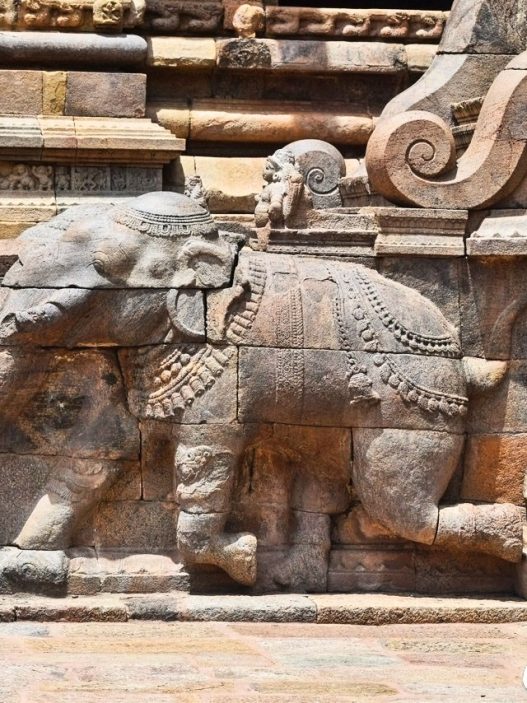


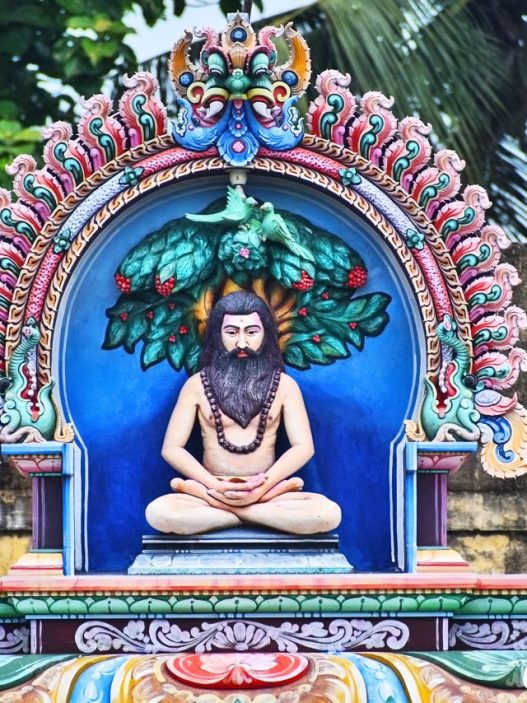

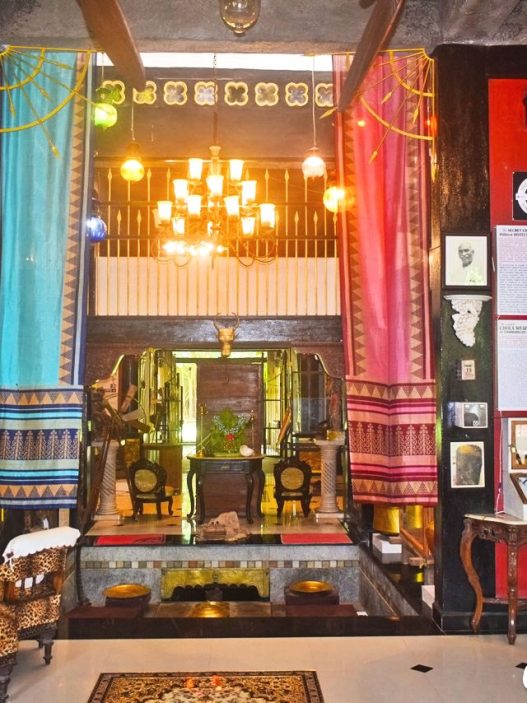
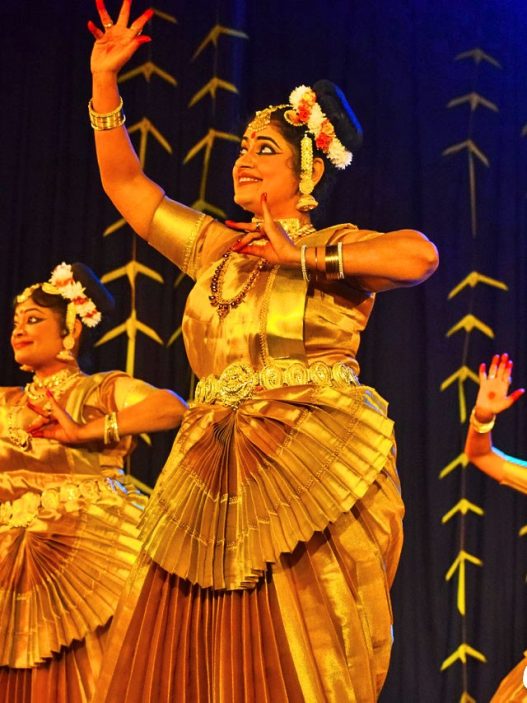

220my1
Touche. Great arguments. Keep up the good spirit.
I’ve been browsing online more than 3 hours today, but I never discovered any interesting article like yours. It’s pretty price sufficient for me. In my view, if all webmasters and bloggers made just right content as you probably did, the web might be much more useful than ever before.
What’s Happening i am new to this, I stumbled upon this I’ve found It positively useful and it has helped me out loads. I hope to contribute & help other users like its aided me. Great job.
I do believe all the ideas you have introduced on your post. They are really convincing and can certainly work. Still, the posts are too short for novices. May you please extend them a bit from next time? Thank you for the post.
I regard something truly interesting about your website so I bookmarked.
Great – I should certainly pronounce, impressed with your site. I had no trouble navigating through all the tabs as well as related info ended up being truly simple to do to access. I recently found what I hoped for before you know it in the least. Quite unusual. Is likely to appreciate it for those who add forums or anything, web site theme . a tones way for your customer to communicate. Nice task..
As a Newbie, I am constantly browsing online for articles that can benefit me. Thank you
I went over this website and I think you have a lot of superb info, saved to favorites (:.
Hi my loved one! I want to say that this post is amazing, great written and include approximately all significant infos. I?¦d like to peer more posts like this .
kwlw86
Bạn có thể xem nhanh tỷ lệ kèo khoảng 15 phút trước khi trận đấu chính thức bắt đầu. Chúng tôi cho phép người chơi so sánh ODDS trước khi vào tiền. Ngoài ra, đăng nhập 66b còn phát sóng trực tiếp với hơn 4.500+ giải đấu mỗi ngày như: NHA, Primera, Ligue 1, Division, Bundesliga,…
I am not very wonderful with English but I get hold this really leisurely to translate.
https://t.me/officials_pokerdom/3978
slot365 login link Nếu bạn muốn chơi game thỏa thích với thương hiệu này, bạn hãy tải và cài đặt ứng dụng từ link chính thức của chúng tôi. Điều này giúp đảm bảo an toàn và tránh các rủi ro từ những nguồn không rõ ràng. Sau khi tải ứng dụng, bạn có thể đăng ký tài khoản và bắt đầu trải nghiệm ngay.
Great summary
Just wish to say your article is as amazing. The clearness to your post is simply spectacular and that i can suppose you are an expert in this subject. Well together with your permission let me to clutch your RSS feed to keep updated with approaching post. Thank you 1,000,000 and please keep up the rewarding work.
Great blog right here! Also your site loads up very fast! What web host are you the use of? Can I get your affiliate hyperlink in your host? I wish my site loaded up as fast as yours lol
I wish to show my love for your generosity for persons who absolutely need guidance on your field. Your personal commitment to passing the solution around had been exceedingly valuable and has consistently empowered associates just like me to arrive at their pursuits. Your new useful guidelines denotes so much a person like me and much more to my colleagues. With thanks; from each one of us.
https://digi44sa.netlify.app/research/digi44sa-(456)
If full skirts and punchy prints aren’t your mom’s go-to, strive
a press release sleeve.
https://je-tall-marketing-826.lon1.digitaloceanspaces.com/research/je-marketing-(477).html
A gown with jewels at the neckline alleviates the need for a necklace or a great deal of other extras.
https://fr-asia-9.blr1.digitaloceanspaces.com/research/asia-business-(4020).html
Now, I just want to recollect all this when my
son will get married.
https://jekyll.s3.us-east-005.backblazeb2.com/20250904-8/research/je-marketing-(162).html
Beach weddings are extra laid-back and casual than different kinds of
nuptials—and a proper gown would really feel misplaced.
https://je-tal-marketing-914.lon1.digitaloceanspaces.com/research/je-marketing-(210).html
For a mother, watching your daughter stroll
down the aisle and marry the love of her life is an unforgettable second.
https://filedn.eu/lXvDNJGJo3S0aUrNKUTnNkb/marketing-798/research/je-marketing-(454).html
Current in style developments feature lace, prints,
fashionable empire waistlines and jackets.
https://fr-tour-6.ams3.digitaloceanspaces.com/research/star-(2822).html
For her, that included a couture Karen Sabag ball gown fit for a princess.
https://filedn.eu/lXvDNJGJo3S0aUrNKUTnNkb/marketing-798/research/je-marketing-(187).html
Use these as statement pieces, maybe in a brighter color than the relaxation of the outfit.
https://filedn.eu/lXvDNJGJo3S0aUrNKUTnNkb/marketing-827/research/je-marketing-(175).html
An imported diamond in the tough, the Adrianna Papell Floral Beaded Gown is a true stunner.
https://je-tal-marketing-955.lon1.digitaloceanspaces.com/research/je-marketing-(306).html
Check out our choices for petite mom of the bride dresses!
https://je-tal-marketing-906.lon1.digitaloceanspaces.com/research/je-marketing-(363).html
Thus, it is essential to speak to the bride to ask about what the
marriage might be like.
https://fr-box-2.sfo3.digitaloceanspaces.com/research/paris-(979).html
If you’ll find something with flowers even if it’s lace
or embroidered.
https://je-tal-marketing-980.lon1.digitaloceanspaces.com/research/je-marketing-(415).html
Its bateau neckline, three-quarter size sleeves, and
full A-line skirt make it flattering, in addition.
https://je-tal-marketing-928.lon1.digitaloceanspaces.com/research/je-marketing-(251).html
But it’s necessary to verify in with the bride before you make any decisions.
https://je-tal-marketing-902.lon1.digitaloceanspaces.com/research/je-marketing-(204).html
These gowns are chic and fashionable with only a
bit of an edge.
https://fr-tour-3.atl1.digitaloceanspaces.com/research/star-(1200).html
Most important thing is that you’re snug and never going to over heat.
https://fr-size.nyc3.digitaloceanspaces.com/research/%EF%B8%8F-small-(212).html
Thus, you shouldn’t wear white when you are the mom of the bride or even something like ivory.
https://je-tal-marketing-976.lon1.digitaloceanspaces.com/research/je-marketing-(444).html
With that in mind, you are totally entitled to need an outfit that lives up to the big day.
https://fr-korea-4.tor1.digitaloceanspaces.com/research/beauty-(1938).html
If you favor impartial tones, gold and silver clothes are promising decisions for an MOB!
https://je-tal-marketing-892.lon1.digitaloceanspaces.com/research/je-marketing-(78).html
Draw inspiration from mix-and-match bridesmaid attire by selecting a colour that coordinates with, however would not precisely match, the maids
palette.
https://je-tal-marketing-893.lon1.digitaloceanspaces.com/research/je-marketing-(120).html
One reviewer said they wore a white jacket excessive but
you would additionally select a wrap or bolero.
https://fr-well-6.ams3.digitaloceanspaces.com/research/%EF%B8%8F-france-(2682).html
Many ladies are concerned about exposing their upper arms.
https://je-tall-marketing-842.lon1.digitaloceanspaces.com/research/je-marketing-(428).html
You could, in fact, select a maxi dress for your special occasion.
https://marketing-research2.ams3.digitaloceanspaces.com/research/research-for-asia-study-(1989).html
Give them glitz and glam on this allover sequin stunner.
https://je-tal-marketing-917.lon1.digitaloceanspaces.com/research/je-marketing-(223).html
Pair the gown with neutral or metallic accessories to maintain the
relaxation of the look subtle and simple.
https://je-tal-marketing-932.lon1.digitaloceanspaces.com/research/je-marketing-(397).html
We’re in love with the muted florals on this romantic mother-of-the-bride robe.
https://fr-well-2.sfo3.digitaloceanspaces.com/research/%EF%B8%8F-france-(872).html
Wear yours with a strappy block heel–a stylish and sensible solution for
an outside marriage ceremony.
https://je-tall-marketing-847.lon1.digitaloceanspaces.com/research/je-marketing-(22).html
As mother of the bride, you might need to discover a look which complements these parts, with out being
matchy-matchy.
https://je-tal-marketing-979.lon1.digitaloceanspaces.com/research/je-marketing-(73).html
I have personally made the mistake of sticking to a low price range for
a high-profile occasion and I still remorse it today!
https://fr-box-6.ams3.digitaloceanspaces.com/research/paris-(2619).html
While you don’t wish to look like a bridesmaid , it’s
savvy to tie in your look with the texture and color palette of the marriage.
https://je-tal-marketing-965.lon1.digitaloceanspaces.com/research/je-marketing-(24).html
With over star reviews, you can be positive this gown will exceed your (and your guests!) expectations.
https://je-tal-marketing-940.lon1.digitaloceanspaces.com/research/je-marketing-(274).html
Talk to your daughter or future daughter- in-law to get a really feel for the
visible she’s attempting to create.
https://filedn.eu/lXvDNJGJo3S0aUrNKUTnNkb/marketing-801/research/je-marketing-(167).html
Plus, a blouson sleeve and a ruched neckline add
to this silhouette’s romantic vibe.
https://fr-tour5.lon1.digitaloceanspaces.com/research/star-(2118).html
This embellishment on this attractive dress adds a touch of magic good for any winter wedding.
https://je-tall-marketing-863.ams3.digitaloceanspaces.com/research/je-marketing-(243).html
Sleeveless, short-sleeved, or 3/4 length, there may be an option for
nearly everyone!.
https://filedn.eu/lXvDNJGJo3S0aUrNKUTnNkb/marketing-798/research/je-marketing-(264).html
Sort via our full selection of clothes to seek out your good fit
in many colours and any dimension.
https://je-tall-marketing-843.tor1.digitaloceanspaces.com/research/je-marketing-(12).html
Sheer stretch tulle and cap sleeves on the neckline add an eye-catching element, giving
the phantasm of a strapless look.
https://je-tal-marketing-912.lon1.digitaloceanspaces.com/research/je-marketing-(283).html
You actually need to think about what’s greatest for the season, and the climate you’ll be sitting in.
https://je-tal-marketing-947.lon1.digitaloceanspaces.com/research/je-marketing-(71).html
You can show a little bit of cleavage, but
too much can seem a bit inappropriate.
https://fr-asia-10.syd1.digitaloceanspaces.com/research/asia-business-(4707).html
Make sure you’re both sporting the identical formality of costume as well.
https://fr-size-8.sgp1.digitaloceanspaces.com/research/%EF%B8%8F-small-(3867).html
Montage by Mon Cheri designer Ivonne Dome designs this big
day line with the delicate, fashion-forward mom in thoughts.
https://fr-accounting-10.syd1.digitaloceanspaces.com/research/Accounting-market-(4523).html
As a mom of a daughter who’s already married, the looking for both her dress and mine was one of the
highlights of the marriage planning.
https://fr-well-1.nyc3.digitaloceanspaces.com/research/%EF%B8%8F-france-(74).html
Regardless of her choice, chances are she has one, so be sure to know what it’s.
https://fr-world-10.syd1.digitaloceanspaces.com/research/cake-(4799).html
So, go ahead, and let the natural shine of your costume speak quantity for you.
https://je-tal-marketing-956.lon1.digitaloceanspaces.com/research/je-marketing-(441).html
In common, you’ll do your best to keep away from
matching with the bridesmaids or the moms of the couple getting
married.
https://je-tal-marketing-952.lon1.digitaloceanspaces.com/research/je-marketing-(309).html
For a seashore marriage ceremony I would put on something a bit more flowy
like the flowery and ruffly dresses above.
https://je-tall-marketing-865.lon1.digitaloceanspaces.com/research/je-marketing-(141).html
You can match elegant strapless robes with objects such as
a jacket or shawl.
https://fr-korea-7.fra1.digitaloceanspaces.com/research/beauty-(3066).html
This black gown is ideal if you are looking for something extra traditional.
https://je-tal-marketing-966.lon1.digitaloceanspaces.com/research/je-marketing-(72).html
This outfit’s intricate corded embroidery and understated black skirt are a match made in heaven—just
like your daughter and their soon-to-be spouse.
https://fr-accounting-7.fra1.digitaloceanspaces.com/research/Accounting-market-(2591).html
Karen Kane has stunning choices that look slightly extra casual in case you
are not in search of a full gown.
Solid analysis
https://fr-accounting-5.lon1.digitaloceanspaces.com/research/Accounting-market-(2138).html
As versatile as is elegant, this icy blue frock is the perfect transition piece to take you from
the ceremony to the reception.
https://je-tal-marketing-966.lon1.digitaloceanspaces.com/research/je-marketing-(408).html
You might go for a nice gown with draping across the mid
area in black and white print.
https://je-tal-marketing-921.lon1.digitaloceanspaces.com/research/je-marketing-(133).html
I even have personally made the error of sticking to a low finances for a high-profile
occasion and I still regret it today!
https://filedn.eu/lXvDNJGJo3S0aUrNKUTnNkb/marketing-801/research/je-marketing-(278).html
The two appears beneath are good examples of timeless type.
https://je-tal-marketing-950.lon1.digitaloceanspaces.com/research/je-marketing-(282).html
This mom’s knee-length patterned costume completely matched the temper of her child’s out of doors wedding
venue.
https://je-tal-marketing-944.lon1.digitaloceanspaces.com/research/je-marketing-(152).html
A matching white choker topped off this mother-of-the-bride’s look,
which was also complemented by a chic low bun.
https://fr-box-3.atl1.digitaloceanspaces.com/research/paris-(1210).html
“I wanted my women to have fun,” the bride mentioned of the choice.
https://je-tal-marketing-923.lon1.digitaloceanspaces.com/research/je-marketing-(55).html
So, at the very least, both mothers will wish to put on colors that complement the opposite.
https://je-tal-marketing-945.lon1.digitaloceanspaces.com/research/je-marketing-(216).html
The sleek silk material glides seamlessly over your figure, however an ankle-length skirt, excessive
neckline and draped sleeves hold issues modest.
https://je-tal-marketing-937.lon1.digitaloceanspaces.com/research/je-marketing-(348).html
This beautiful robe is produced from double-stretch Mikado for a streamlined,
comfortable fit.
https://je-tal-marketing-961.lon1.digitaloceanspaces.com/research/je-marketing-(144).html
And finally, don’t worry about trying to solely
‘age-appropriate’ boutiques.
https://fr-tour-3.atl1.digitaloceanspaces.com/research/star-(1272).html
With that in mind, you are absolutely entitled
to want an outfit that lives up to the special day.
https://je-tal-marketing-976.lon1.digitaloceanspaces.com/research/je-marketing-(350).html
Stylish blue navy costume with floral pattern lace and wonderful silk lining, three-quarter
sleeve.
https://je-tall-marketing-865.lon1.digitaloceanspaces.com/research/je-marketing-(472).html
The shape of your costume can cover everything from a small bust to giant hips.
https://fr-box-2.sfo3.digitaloceanspaces.com/research/paris-(649).html
Always think about the sorts of sleeves and straps
you’ll have in your costume.
https://je-tal-marketing-976.lon1.digitaloceanspaces.com/research/je-marketing-(276).html
You’ll merely glow on this shimmering gold gown by Aidan Mattox.
https://fr-world-1.nyc3.digitaloceanspaces.com/research/cake-(280).html
This off-the-shoulder type would look great with a pair of strappy stilettos and shoulder-duster earrings.
https://je-sf-tall-marketing-737.b-cdn.net/research/je-marketing-(83).html
This exquisite floral frock would make the right complement to
any nature-inspired wedding ceremony.
https://fr-box-1.nyc3.digitaloceanspaces.com/research/paris-(83).html
Otherwise, photographs will appear off-balanced, and it may be misconstrued that one mom is trying to outshine or outdo the opposite.
https://fr-tour-1.nyc3.digitaloceanspaces.com/research/star-(56).html
Here’s another top-of-the-line mother-of-the-bride dresses
you can buy on-line.
https://je-tall-marketing-828.fra1.digitaloceanspaces.com/research/je-marketing-(175).html
For example, you may go together with a lighter tone or darker shade of the
colour the bridesmaids are carrying.
https://fr-size-2.sfo3.digitaloceanspaces.com/research/%EF%B8%8F-small-(822).html
Shop beautiful wedding clothes for the mother-of-the-bride in commonplace, plus and petite sizes at
Adrianna Papell.
https://je-tal-marketing-892.lon1.digitaloceanspaces.com/research/je-marketing-(12).html
We’re in love with the muted florals on this romantic mother-of-the-bride gown.
https://fr-size-8.sgp1.digitaloceanspaces.com/research/%EF%B8%8F-small-(3671).html
Matching your MOB gown is a enjoyable approach to present you consideration to element.
https://fr-well-9.blr1.digitaloceanspaces.com/research/%EF%B8%8F-france-(4194).html
Stick to a small yet stately earring and a cocktail ring, and hold additional sparkle to a minimal.
https://je-tal-marketing-892.lon1.digitaloceanspaces.com/research/je-marketing-(439).html
Discover our hand-picked assortment of mother of the bride attire and you’re guaranteed to be best-dressed – apart from the bride,
of course!
https://je-tal-marketing-972.lon1.digitaloceanspaces.com/research/je-marketing-(458).html
My daughter desires of a wedding on a seaside in Bali,
so the place will that depart me I marvel.
https://je-sf-tall-marketing-736.b-cdn.net/research/je-marketing-(286).html
You might mix the monochrome twinset with white or black pants.
https://fr-korea-3.atl1.digitaloceanspaces.com/research/beauty-(1138).html
Shop beautiful wedding attire for the mother-of-the-bride in commonplace,
plus and petite sizes at Adrianna Papell.
https://fr-asia-3.atl1.digitaloceanspaces.com/research/asia-business-(1459).html
If chic and complicated is what you are going for, contemplate this sequined ensemble from Alex Evenings.
https://je-tal-marketing-942.lon1.digitaloceanspaces.com/research/je-marketing-(214).html
Black is also another dangerous shade, however can work completely nicely
at extra formal weddings.
https://je-tal-marketing-977.lon1.digitaloceanspaces.com/research/je-marketing-(137).html
Browse our prime choices and buy your favourite proper on the
spot.
https://fr-box-4.tor1.digitaloceanspaces.com/research/paris-(1718).html
Stick to a small but stately earring and a cocktail ring, and
keep further sparkle to a minimum.
Alright, Meritkingbahisscript… This one’s for the programmers out there, right? Sounds like a cool tool if you’re into that sort of thing. Dunno much about coding myself, but good luck! Looks interesting: meritkingbahisscript
https://je-tal-marketing-929.lon1.digitaloceanspaces.com/research/je-marketing-(169).html
But it’s necessary to verify in with the bride earlier than you make any selections.
https://je-tal-marketing-952.lon1.digitaloceanspaces.com/research/je-marketing-(492).html
Even as a visitor to a marriage I have made a few errors in the past.
https://je-sf-tall-marketing-727.b-cdn.net/research/je-marketing-(257).html
This will full your outfit and bring it together as a whole.
https://je-tal-marketing-970.lon1.digitaloceanspaces.com/research/je-marketing-(456).html
You may think it’s customary for the mother of the bride to wear an over-sized hat, however that’s simply not
the case for 2022.
https://je-tal-marketing-979.lon1.digitaloceanspaces.com/research/je-marketing-(351).html
For warm-weather weddings and intimate affairs outdoor, style your bridal party—and most significantly,
your mother—to the theme.
https://je-tal-marketing-935.lon1.digitaloceanspaces.com/research/je-marketing-(188).html
You’ve helped her discover her dream costume, now allow us to
assist you to discover yours…
https://je-tal-marketing-967.lon1.digitaloceanspaces.com/research/je-marketing-(109).html
There are plenty of options available for plus measurement mother of the bride attire.
I’m not that much of a internet reader to be honest but your sites really nice, keep it up! I’ll go ahead and bookmark your website to come back in the future. Many thanks
https://je-tal-marketing-969.lon1.digitaloceanspaces.com/research/je-marketing-(14).html
They have been serious about it since childhood, planning every…
https://je-tal-marketing-955.lon1.digitaloceanspaces.com/research/je-marketing-(428).html
This costume is on the market in sizes 2 – 22 to
fit a wide range of physique kinds.
https://e-tall-marketing-832.tor1.digitaloceanspaces.com/research/je-marketing-(339).html
A mom is a ray of shine in a daughter’s life,
and so she deserves to get all glitzy and gleamy in a sequin MOB costume.
https://je–marketing-834.lon1.digitaloceanspaces.com/research/je-marketing-(133).html
This bride’s mother escorted her down the aisle in a floor-length golden gown with a floral overlay.
https://je-sf-tall-marketing-732.b-cdn.net/research/je-marketing-(302).html
So, we’ve compiled a information to one of the best mother of the bride outfits and trends for 2022.
https://je-tall-marketing-829.sgp1.digitaloceanspaces.com/research/je-marketing-(385).html
Now, I simply want to recollect all this when my son will get married.
https://t.me/s/ef_beef
hello there and thanks in your information – I’ve definitely picked up anything new from proper here. I did then again expertise several technical issues the usage of this web site, since I skilled to reload the website lots of occasions prior to I may get it to load properly. I have been pondering if your hosting is OK? Now not that I am complaining, however sluggish loading circumstances times will sometimes affect your placement in google and can damage your high-quality score if ads and ***********|advertising|advertising|advertising and *********** with Adwords. Anyway I am including this RSS to my email and could glance out for a lot extra of your respective fascinating content. Ensure that you update this again very soon..
Im not sure the place you are getting your info, however good topic. I needs to spend a while learning much more or figuring out more. Thank you for excellent information I was searching for this information for my mission.
Insgesamt hat „Casino“ einen bleibenden Eindruck in der Filmgeschichte hinterlassen und wird immer als
ein Meisterwerk des Gangsterfilms in Erinnerung bleiben. Ungeachtet der Tatsache, das es nur ein Film ist, haben auch echte Spielcasinos Altersfreigaben für die Teilnahme.
Laut Rüdiger Suchsland (artechock.de) zeigt die Mafia einzigartig die dunklen Seiten vom Kapitalismus,
und verdient die Aufmerksamkeit von der Filmindustrie und Scorsese.
Schwarze Letter, inmitten eines infernalischen Orkans, der sich über den gesamten Bildschirm erstreckt und auch Sam Rothstein (Robert De Niro,
„Die durch die Hölle gehen“) in die Höhe gerissen hat.
Heftfilme.com existiert bereits seit dem Jahr 2005 und hat seinen Schwerpunkt
auf DVD-Zeitschriften mit Filmen. Nach „Lexikon des internationalen Films“ zeigt der Film analytisch die Spielerstadt Las
Vegas, sowie beschreibt die Wirkung von Macht, Geld und Stolz, wobei
man dennoch keinen Zugang zu den Emotionen der Hauptfiguren erhalte.
Das Mafia-Syndikat Chicago Outfit beauftragt ihn damit, den täglichen Hotel- und
Casinobetrieb im Tangiers Spielcasino von Las Vegas zu leiten. Die Handlung
im Film „Casino“ erzählt die Geschichte der Mafia, die den Spieler Sam
„Ace“ Rothstein (Robert De Niro) dazu bringt,
ein Spielcasino in Las Vegas zu betreiben. „Casino“ ist ein Kriminalfilm-Drama
aus dem Jahr 1995 vom Regiseur Martin Scorsese.
References:
https://online-spielhallen.de/bassbet-casino-login-schnell-sicher/
• In unseren Tischspiele-Bestsellern wie Poker, European Roulette oder Blackjack fühlst du
dich wie in Vegas. In unserem Online Casino sind Ranglistenspiele mit verschiedenen Themen besonders beliebt
– bei den vielen Top-Chancen auf Gewinne kein Wunder!
Casino-Spiele von Novoline, egal ob im Spielgeldmodus wie auf Gametwist oder in Echtgeld-Versionen, erzählen oft außergewöhnliche Geschichten. Die Freispiele übernehmen in diesem Automat sowohl
den Einsatz als auch die Linienanzahl deines letzten Regulärspiels.
Nach dem Login lässt die Seite aufgrund einer großen Auswahl an Brett-
und Kartenspielen die Herzen der Zocker höherschlagen. Für wen es sich anbietet, trotzdem bei dem Anbieter zu
spielen, verraten wir euch in diesem Artikel über GameTwist mit Echtgeld.
Oder wie wäre es mit verlinkten Jackpots oder Promotions
mit Freispielen? Neben Spielautomaten kannst du auch echte Casino-Klassiker wie Roulette oder Blackjack spielen und auf Gewinnjagd gehen!
In Faust ist es als Spieler deine Aufgabe, 5 gleiche Symbole direkt nebeneinander – also ohne Unterbrechung durch andere Symbole – auf einer
der Gewinnlinien zu erspielen. Auch GameTwist bietet zahlreiche
Varianten dieser eleganten Tischspiele an,
und das dank der vielen Twist-Boni oftmals
sogar gratis. Wer mit dem Mobilgerät spielen möchte, muss nicht zwingend eine App herunterladen. Es
gibt verschiedene Pakete zu guten Konditionen, sodass das Spielen von Slots und Karten- und Tischspielen problemlos möglich ist.
References:
https://online-spielhallen.de/nomini-casino-bonus-code-ihr-weg-zu-spannenden-angeboten/
Teilen Sie Ihre Meinung mit oder erhalten Sie Antworten auf Ihre
Fragen. Folglich wurde die Beschwerde aufgrund mangelnder Kommunikation abgelehnt,
sodass die Spielerin die Möglichkeit hatte, den Fall bei Bedarf in Zukunft
erneut zu eröffnen. Infolgedessen wurde die Beschwerde aufgrund fehlender weiterer Informationen für
die Untersuchung abgelehnt. Das Beschwerdeteam konnte ihm aufgrund der fehlenden Reaktion des
Spielers auf Anfragen nicht weiterhelfen, was zur Ablehnung der
Beschwerde führte. Der Fall wurde als gelöst markiert und der Spieler dankte
sowohl dem Casino als auch dem Beschwerdeteam für ihre Bemühungen.
Insgesamt bietet Mro Casino ein solides und attraktives Online-Spielerlebnis.
Zusätzlich bietet das Casino einen umfangreichen FAQ-Bereich, in dem viele häufig gestellte Fragen bereits beantwortet werden.
Mro Casino stellt sicher, dass Spieler bei Fragen oder Problemen jederzeit kompetente Unterstützung
erhalten. Mro Casino bietet zahlreiche Tools zur Unterstützung verantwortungsvollen Spielens.
Mro Casino bietet eine breite Auswahl an sicheren und schnellen Zahlungsmethoden, die speziell auf den deutschen Markt ausgerichtet sind.
References:
https://online-spielhallen.de/lemon-casino-deutschland-eine-insider-analyse-aus-spielersicht/
Nutzt man beispielsweise einen Willkommensbonus geschickt,
werden oft bis zu 100% mehr bereitgestellt.
Die Praxistests liefern transparente Einblicke.BonusangeboteMit Boni hat man häufig die Möglichkeit, das Guthaben für Online Spielautomaten mit
Echtgeld zu erhöhen. Lizenz und SicherheitDas beste Echtgeld Casino verfügt über gültige Lizenzpapiere.
Spielt man in Online Casinos mit Echtgeld, setzt man das eigene
Budget ein.
Von klassischen Tischspielen über aufregende Slot Casino Spiele
bis hin zu innovativen Live-Casino-Erfahrungen, gibt es etwas für
jeden Geschmack und jedes Interesse. Spieler können die
Spannung eines realen Casinos erleben, während
sie bequem von zu Hause aus spielen. Diese Seiten bieten Spiele mit hohen RTPs
(Return to Player), was bedeutet, dass Spieler eine höhere Chance auf Gewinne haben, besonders bei Online Casino Echtgeld Spielen.
References:
https://online-spielhallen.de/lucky-dreams-casino-cashback-deine-chance-auf-ruckerstattung/
The way you connected these seemingly unrelated ideas is brilliant and opened up entirely new possibilities for me. I’ve already started exploring some of the intersections you mentioned. This kind of interdisciplinary thinking is exactly what we need more of.
Hi there, I discovered your website via Google whilst searching for a comparable matter, your web site came up, it looks great. I’ve bookmarked it in my google bookmarks.
I would like to thnkx for the efforts you have put in writing this blog. I am hoping the same high-grade site post from you in the upcoming also. Actually your creative writing skills has encouraged me to get my own blog now. Really the blogging is spreading its wings rapidly. Your write up is a great example of it.